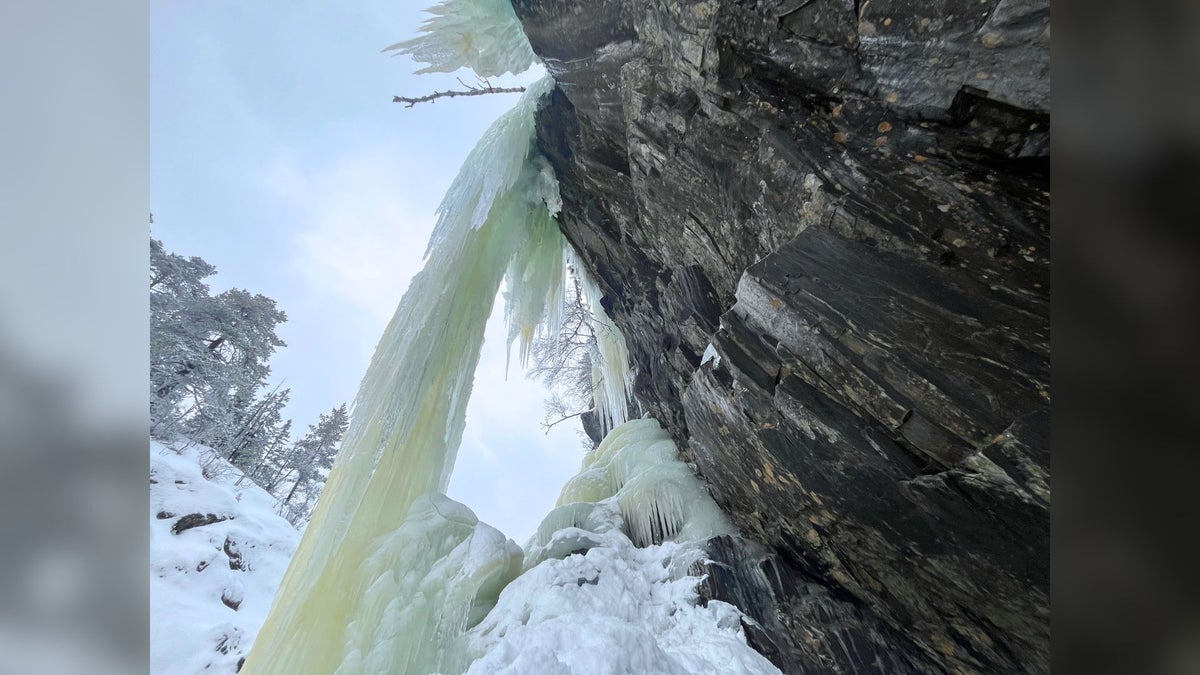
A pillar's verticality leads to strenuous climbing, and the skinniest of them are prone to collapse if conditions aren’t just right. We asked three expert ice climbers for their advice.
The post How to Know If an Ice Pillar is Stable appeared first on Climbing.
]]>
Though beautiful and inviting, pillars are also intimidating. Their verticality leads to strenuous climbing, and the skinniest pillars are prone to collapse if conditions aren’t just right. We asked three expert ice climbers for their advice on pillar climbing: Roger Strong, a prolific first ascensionist from Seattle, Washington; Dawn Glanc, a climbing guide from Ouray, Colorado; and Raphael Slawinski from Calgary, one of Canada’s foremost ice climbers. Above all, they agreed, super-skinny pillars must be approached very cautiously.
Safety and stability
Before you attempt an ice pillar, you need to judge whether it’s solid enough to bear your weight and repeated strikes from your tools and crampons. In the 2010s, the 120-foot Fang pillar in Vail, Colorado, collapsed in early season when it wasn’t formed sufficiently—the climber on board barely survived the crash. And, of course, there’s this horrifying video from Canada. The pillar’s size and attachment, the condition of the ice, and the temperature before and during a climb all affect stability.
“Something I read a long time ago has stayed with me: Never climb a feature you’re afraid to stand under,” says Raphael Slawinski. “It seems like this would be clear, but we don’t always follow this obvious bit of advice.”
Assuming a pillar passes the stand-under-it test, consider recent weather and ice conditions. Bitter cold can make ice brittle and more likely to break— especially if there was a sharp drop in temperature in the day or two before your attempt. Although there are many variables, the ideal temperature range for well-frozen but non-brittle ice is around 25 to 30 degrees Fahrenheit.
Also, look out for horizontal fractures splitting the pillar—these often form just below the point where a free-standing pillar attaches to the wall above, as the pillar shifts and settles. Try to assess whether such a break passes completely through the ice, making the pillar unstable, or has partly filled in and refrozen, restoring the pillar’s strength.
“If I’m inspired to hop on a really thin pillar, I try to research the significant weather patterns leading up to it, such as how many melt/freeze cycles it has gone through,” says Roger Strong. More melting and refreezing generally makes a pillar stronger. “I also look at what’s above it, and the consequences below if it rips while I’m on it. I push and lightly tap all around the base to get a feel for the integrity. Then I’ll spend time doing just a few moves to get a feel for if it should be climbed or not, going one or two moves higher each time and then downclimbing. If all the senses are giving me the green light, I’ll commit to the radness. If not, I bail.”
When in doubt, toprope. Whether the climber is leading or toproping, the belayer should be positioned to one side or well sheltered from falling ice.
Protection
If a pillar is as wide as a car and mostly attached to the rock behind it, you can protect it with ice screws just as you would any other climb. But when a pillar spans the mouth of a cave from top to bottom like a snake’s fang, you’ll need extra precaution, especially when the spindle narrows to body width.
“My guideline for actually placing a screw in a pillar is it has to be around six to eight feet in diameter at the base,” Strong says. “This typically means this climb has taken a while to form and has survived a few melt/freeze cycles, contracted and expanded, and had the chance to settle.”
Sometimes you may be able to place bomber protection in the rock behind or beside a thin pillar. But if that’s not an option, the safest way to climb skinnier pillars may be to run it out. Place a solid screw or two below the foot of the pillar (often there’s a pedestal of solid ice below the spindle itself), and then don’t place another screw until you’re above the attachment point to the wall behind. This obviously requires careful judgment of the risk of a long fall versus the risk of pulling down the pillar, but since placing pro is strenuous on steep ice, you will be conserving strength as you conserve the integrity of the pillar.
Whether you run it out or place screws for protection, the old saying “the leader must not fall” is never more appropriate than on a skinny pillar. Climb slowly and well within your limits.

Movement
A skinny pillar narrows your options for tool and foot placements, and likely will force you out of the stable triangle position typically used on broad ice flows. You may find yourself pigeon-toed on a skinny pillar, and you’ll draw on rock climbing techniques to stay in balance.
“The main thing is good footwork—maintaining a balanced position,” says Dawn Glanc. “You may be doing that by standing on one foot and flagging the other foot to one side for balance. When you get ready to swing, suck your hips into the ice, with a nice arched back, to keep your weight over your feet.” On very narrow pillars, you may be able to wrap one leg around and behind the ice and squeeze it for better balance and purchase.
On brittle or fragile ice, especially at the foot of a skinny pillar, move very gently: Think tapping, pecking, and then hooking with your tools rather than swinging. Use those same divots for your crampon points (monopoint crampons help here). Step up as if you were moving up a face climb on rock, letting your body weight drive the crampon points into the ice. Make sure your picks and crampon points are razor sharp.
Never place your tools side by side horizontally on a thin or fragile pillar, or you risk creating a fracture. Instead, reach high to place the next tool at least six to eight inches above the other.
With aggressive curved tools, you can bump your hands up to the higher grips on the shaft for longer reaches. If you have one arm with more lock-off strength, like your right arm, you may choose to make more long reaches with that arm, Strong says. Get a high placement with your left tool, then match hands on the shaft of this higher tool. Now remove the lower tool with your left hand, lock off with the right again, and place high with the left.
Keep an eye out for knobs, holes, or ridges of ice where you can flat-foot a crampon or back-step for a more restful stance. If you find a stem rest, milk it.
You’ll likely be pumped at the top of a pillar and tempted to punch it to the belay. But the abrupt transition to lower-angled ice may be the crux of a steep pitch. Even if you’re pumped, stop and place a good screw before topping out.
Keeping it together
Pillars are pumpy, and the intensity of the climbing tends to make them feel even pumpier. To keep his forearms fresh, Strong says, “I like to move slowly and take the mental attitude that it’s like a 5.10 jug haul at the gym. After every three to four steep tool placements, I stop and relax into the curve of the pommel (the big grip at the base of the shaft) as if I’m resting on a jug.”
Fear contributes to the pumpiness of pillars. Your heart rate goes up, and you begin to clutch the tools with a death grip. As on a hard rock climb, remind yourself to breathe steadily. “You have to accept that you’re putting it out there and may not get gear for a while,” Glanc says. “Focus on the process and technique, and you’ll soon be up the pitch.”
The post How to Know If an Ice Pillar is Stable appeared first on Climbing.
]]>
Head trauma is among the most feared and catastrophic injuries in climbing. So why aren't more rock climbers wearing helmets?
The post Why Do So Many Climbers Not Wear Helmets? appeared first on Climbing.
]]>
This article was originally published in 2013 and has been updated where relevant—Ed.
Beth Rodden didn’t expect trouble on the Central Pillar of Frenzy on Yosemite’s Middle Cathedral Rock. After all, the 33-year-old superstar had free climbed the Nose of El Cap and put up the Valley’s hardest crack climb, the then-unrepeated 5.14c Meltdown. One of the best female rock climbers on the planet, she had never been injured in a climbing fall. Rodden devoured routes like the Central Pillar without breaking a sweat.
But this mega-popular 5.9 would serve as a reminder of one of climbing’s greatest risks—and also a leading appeal of the sport: that anything can happen, anywhere, anytime, without warning, even on the most familiar terrain. Partway through the first pitch on the Central Pillar, Rodden’s foot slipped on polished granite, flipping her upside-down and into a freefall. Twenty feet down, going approximately 23 mph, the back of her head slammed into rock.
At first, Rodden says, “I didn’t think I was hurt. We actually climbed the rest of the day. But the next night at dinner, I was having a really hard time concentrating. I could see [people talking], but I couldn’t process what they were saying.” Another red flag: Rodden’s forehead was sore, even though she’d hit the opposite side of her head. The next day she went to her doctor, who explained that her brain had slammed forward against her skull upon impact with the rock face. Diagnosis: concussion.
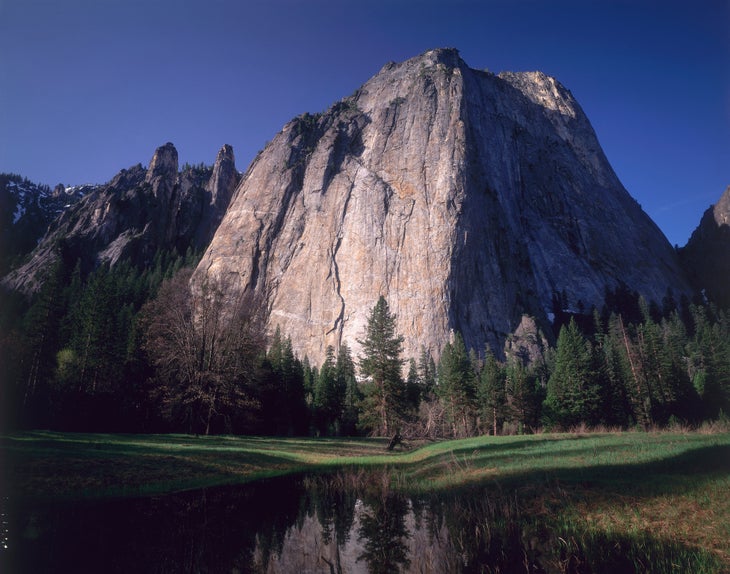
Concussion is only one of many serious head injuries a climber might suffer—others include skull fractures and severe lacerations—but new awareness of concussions’ frequency and their potential long-term effects has caused consumers, manufacturers, and regulators to re-examine many sports and their protective equipment. High-tech anti-concussion helmets are making their way into the cycling and skiing markets, and President Obama declared that if he’d had a son, he might not allow him to play football because of the latest research on traumatic brain injuries. One study, from the Annals of Otology, Rhinology & Laryngology journal, found that an estimated 5,067 patients suffered head and neck injuries from rock climbing nationally from 2009 to 2018. Concussion and closed-head injury was the most common injury at 44 percent. Indeed, there is little doubt that Rodden’s experience could happen to anyone.
Rodden says her recovery was slow, and she wonders if the concussion is to blame when she has trouble concentrating even today. The symptoms of traumatic brain injury can last for weeks or months—and multiple concussions can cause years of problems. The accident caused Rodden to rethink her stance on climbing helmets. “I hardly ever wore a helmet while climbing in Yosemite, but now I always try to wear one, even if the route is easy,” she says.
Climbing Magazine is now 50% off for a limited time. Just $24 a year gets you five print issues (four Climbing, one Ascent) delivered to your door. Subscribers also receive unlimited access to over 5,000 articles on climbing.com.
But sometimes, especially when the climbing is hard, Rodden chooses to leave her helmet behind. When we spoke, she was in Spain for sport climbing on overhanging limestone, and she hadn’t even packed a helmet for the trip.
When it comes to helmets and climbers, inconsistency is everywhere. Most ice climbers and mountaineers wear helmets, as do many traditional rock climbers. But far fewer rock climbers don lids for short climbs, especially sport routes. (Though you can’t rule it out, you’re much less likely to smack your head or suffer rockfall on an overhanging 5.12 sport climb, at the Red River Gorge, Kentucky, for example, than you are on a ledge-filled 5.8 in Eldorado Canyon, Colorado.) Many ice climbers forego their helmets while rock climbing. Some climbers wear a helmet to one crag but not to another. Or they’ll wear it while leading but not while belaying. And given the track record in cycling—around half of all cyclists still don’t always wear helmets, despite a great toll of head injuries—this is not likely to change. Most climbers will continue to make day-by-day decisions about their helmets.
On the surface, this seems nuts. If helmets prevent or mitigate head injuries, shouldn’t a climber always wear one, from the second she arrives at the crag to the moment she starts hiking back to the car? Or is helmet use, like so many aspects of our sport, an issue that resists pat answers?
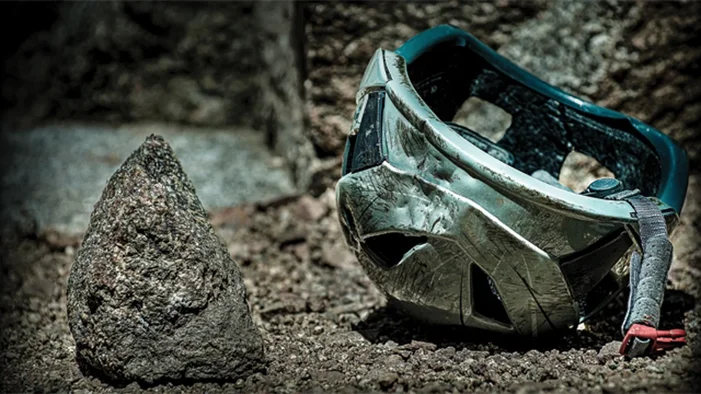
Head injuries, though rare in climbing, are potentially catastrophic.
On a spring day in 2008, Evie Barnes, a 21-year-old boulderer, started up her first trad route, the long, easy east face of the Second Flatiron in Boulder, Colorado. Near the top, her partner asked if she’d like to lead a short step. Barnes fell partway up the pitch, popping out her naively placed pro, and tumbled down the slab. She sprained both ankles, strained a knee and thumb, and chomped a big chunk out of her tongue. Before she came to a stop, she smacked the side of her head just above her left ear against a big flake of conglomerate sandstone.
Barnes was in shock, but other climbers helped her get to the trail and walk down the mountain to her car. She didn’t go to the doctor right away, but then, a couple of days after the fall, a friend told her she was acting “weird.” Barnes says, “I’ve never been much of a crier, but I started randomly crying on my way to work.” A round of visits to neurologists and other specialists soon began. Though no evidence of injury showed up on MRI or CT scans, Barnes began suffering migraines. Her speech slowed, and her motor skills deteriorated. “If I was eating, my fork would just sit there; I couldn’t bring it to my mouth,” she says. “And my legs would crumple beneath me while I was walking.”
Barnes was diagnosed with post-concussive syndrome, a series of symptoms associated with brain injuries, and five years later she’s still trying to find her way back to a full recovery. “My neurologist put me on a seizure medication that helped my migraines but made me act like I was drunk. It was embarrassing,” Barnes says. She tried craniosacral therapy and massage. “Life was doable, and I could work a part-time job, but I never got the energy back that I used to have.”
Last fall, she banged her head against a low ceiling, and some symptoms returned. (Victims of repeated concussions are particularly vulnerable to long-term problems.) Now she’s undergoing hyperbaric treatments, breathing 100 percent oxygen in a chamber for 70 minutes a day. Unable to work full-time, she helps clean the hyperbaric business to pay for treatments she can’t afford. But she’s begun climbing again. “It took a lot of adjustment, because just like with the fork not being able to get to my mouth, my hands didn’t want to move to the next hold,” she says. “I’m definitely not as strong as I was before, and I’m way more cautious. But I’m starting to feel like I can actually train again.”
Luckily for climbers, injuries like Barnes’ are unusual. High-altitude mountaineering is more dangerous: If you venture above base camp on Annapurna, you’ve got about a 1 in 25 chance of dying. By contrast, fatalities in rock climbing and bouldering are very uncommon. Statistically, rock climbing is nowhere near as dangerous as the mainstream media (or your mom) would believe.
[Read: Is Trad Climbing More Dangerous Than Sport Climbing? What 30 Years of Accident Data Tells Us.]
An average of about 30 climbers of all disciplines die each year in the United States, from falling, rockfall, or any other cause—about the same number of skiers and snowmobilers, combined, killed by avalanches annually in the U.S. Compare this with cycling, which kills 600 to 800 riders a year and injures more than 40,000 in the United States—a greater rate of deaths per participant than in climbing. A parent or nurse might argue that 30 deaths is still an unacceptably large number, but compared to other sports perceived as less dangerous, rock climbing is statistically quite safe.
In fact, the huge majority of climbing injuries are non-traumatic—finger and elbow tendonitis, shoulder pain, and similar overuse injuries—or cuts, sprains, broken bones, and other non-life-threatening injuries, mostly in the lower extremities. In 2009, the American Journal of Preventive Medicine published a study by Nicolas Nelson and Lara McKenzie of U.S. Consumer Product Safety Commission data on climbers admitted to emergency rooms. Injuries to the lower extremities accounted for nearly half of the climber ER visits between 1990 and 2007, with ankles bearing the brunt of the damage. In the same study, head injuries (including neck, face, eyes, ears, and mouth) accounted for 12 percent of the total—an average of about 275 a year. (There was no data on who wore a helmet.) Other studies and surveys have shown a 4 to 8 percent rate of head trauma among all climber injuries.
The actual total of head injuries is likely considerably higher than these studies suggest. Some surveys included tendonitis and other non-emergency injuries, and the Nelson-McKenzie study did not account for injured climbers who saw a non-emergency physician (as Rodden and Barnes did), nor did it track fatalities. We also do not know the numbers of unreported head injuries—climbers who took a blow to the head but never saw a doctor.
An average of about 30 climbers of all disciplines die each year in the United States, from falling, rockfall, or any other cause—about the same number of skiers and snowmobilers, combined, killed by avalanches annually in the U.S.
Meanwhile, there’s no doubt that head injuries, though relatively uncommon, often are radically different from other climbing maladies. Inflamed tendons are frustrating and painful, but they rarely require significant medical intervention; broken bones seldom demand hospital stays. By contrast, a quarter of the head injuries in the 2009 survey—more than twice the rate for all climber ER visits—resulted in hospitalization. And as Evie Barnes’ experience shows, the consequences of head impacts can stretch over years.
“Every single doctor said, ‘You should have worn a helmet,'” Barnes says now. “They said I probably still would have gotten a light concussion because I hit so hard, but they had no doubt that if I had a helmet, I would have been way better off.”
Rock climbers wear helmets in some settings but not others.
Not long ago, very few climbers wore helmets, even in the most dangerous situations. Pioneering alpinist and gear maker Yvon Chouinard climbed perilous ice and alpine routes with his head clad only in a yellow-and-purple knit hat. “When I started climbing 25 years ago, it wasn’t cool to wear a helmet,” says Dan Middleton, chief technical officer at the 65,000-member British Mountaineering Council (BMC), which has done extensive helmet research and education. “You’d very rarely see people [using them while] crag climbing. Now that’s changed.”
The vast majority of ice climbers and alpinists wear helmets. But among rock climbers, helmet use varies widely depending on where and how you climb. In a survey of 1,887 rock climbers published in Journal of Trauma in 2006, 36 percent reported wearing helmets most or all of the time, while 19 percent never wore helmets; the rest sometimes or seldom wore them. Another survey of 1,400 rock climbers, completed in 2012 by Kevin Soleil, then a master’s student at the University of Tennessee, Knoxville, found similar patterns. The percentage of respondents who said they usually or always wore a helmet was 49 percent among sport leaders, 53 percent for topropers, and 86 percent for leaders on traditional climbs.
Look around a typical American crag, and Soleil’s numbers will likely seem high. (He cautions his results may be skewed because he did not survey climbers under 18—the mean age in his survey was 36, and younger climbers tend to wear helmets less often than older ones.) Based on multiple observations of sport and traditional crags in Colorado, helmet usage was lower across the board. In Boulder and Clear Creek canyons, at five mid-difficulty sport climbing crags, about 35 percent of leaders were wearing helmets. Less than 20 percent of belayers wore helmets, and only 10 percent of people standing or sitting under climbs wore them. Down the road in Eldorado Canyon, a traditional area known for loose rock and tricky protection, 66 percent of leaders wore helmets, and 45 percent of belayers were helmeted.
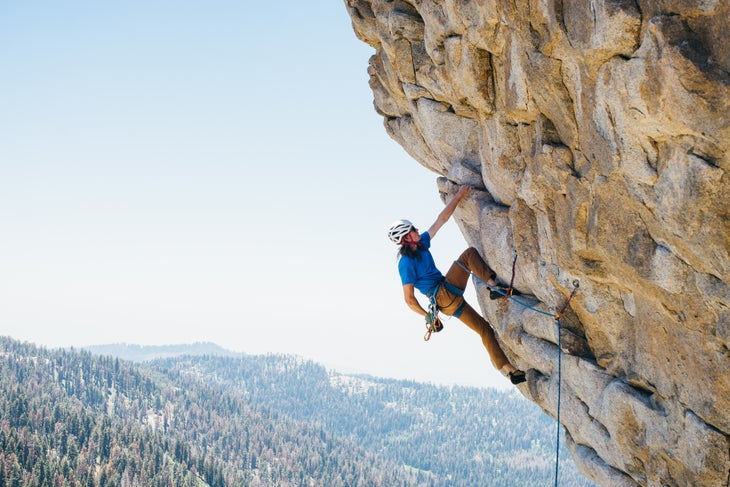
Unsurprisingly, Soleil’s survey suggests that as climbs get steeper and the difficulty higher, especially on sport routes, fewer people wear helmets. Generally, overhanging climbs are less vulnerable to rockfall and impacts with the rock. Chris Weidner, who says a helmet saved his life after a 30-foot fall on El Capitan a decade ago, usually doesn’t wear one anymore for sport climbing. “I can’t think of anybody that sport climbs hard and wears a helmet,” he says. Rodden said during her trip to Spain, “I haven’t seen a single person here wearing a helmet.”
Virtually no one boulders with a helmet, despite the frequent bruising falls many boulderers take. One who does is the father of the bouldering V-grade and author of the Hueco Tanks guidebook, John “Verm” Sherman, who has had multiple concussions and now sports a helmet on highballs and even some butt-draggers. In a column at dpmclimbing.com, Sherman wrote, “These days, if I can’t find a legitimate reason not to wear a helmet, I wear one. Which is 98 percent of the time.”
You can also find rare instances of people climbing indoors with a helmet. Mark Dixon, 55, is an emergency room doctor in Loveland, Colorado, and a 5.12 leader, and every time he ties in to lead a route at the Boulder Rock Club, he also straps on his helmet. “I started wearing a helmet in the gym about a year ago,” he says. “I was taking a lot of falls, and twice in a week flipped upside down and whacked my head. It was nothing serious, but I thought, ‘This is stupid—I wear a helmet biking, climbing outdoors, and caving; why not wear one here, too?'”
For many climbers, the decision whether to wear helmets is not based on safety at all, but more around comfort and fashion. Soleil’s survey found that trad climbers were much more likely to say helmets were comfortable and “acceptable fashion.” Sport climbers were more likely to say a helmet was “unaesthetic” or uncool. (Typical negative comment: “I feel like I stand out at the crag.”) Soleil also found a significant correlation between climbers who don’t wear helmets and those who believe brain buckets “take away from the aesthetic look and feel of a climbing scene,” or that they “reduce performance.”
Though it’s rare, there are cases where a helmet negatively affects climbing performance. Most trad climbers can recount stories of removing a helmet to squeeze through a tight chimney. Helmets also can push your face away from the wall if you’re pulling in close for a delicate move. And for climbers who count the ounces of their quickdraws and choose sub-9mm ropes for redpoints, even a half-pound helmet may be too much to bear.
“A risk-based approach to helmets is what we’re pushing,” says Dan Middleton of the BMC. “We don’t want to just say, ‘Oh, you must wear a helmet.’ Climbing isn’t about rules. We want people to think about the risks and make their own decisions.”
Soleil’s study concluded that rock climbers make some logical risk-based decisions: They tend to wear helmets more often when they perceive greater threat from rockfall or climbs are less steep (thus a climber is more likely to impact something if he falls), and where routes are longer, poorly protected, or farther from medical care. However, the survey also reveals that some climbers make poorly reasoned decisions, including basing their choice on what’s “cool.” And across all types of rock climbing, fewer survey respondents wore helmets while belaying than while leading or following—despite the fact that falling rocks and dropped gear are at least as likely to hit you below a pitch as when you’re actually climbing it.
If you count ice climbers and mountaineers, climbers as a group still don’t wear helmets as often as participants in other head injury–prone sports. After rapid growth in the 1980s, the number of cyclists wearing helmets leveled out at around 50 percent, with the percentage rising as cyclists get older. The National Ski Areas Association reported that 61 percent of skiers and boarders wore a helmet in the 2010/2011 season, up from 25 percent in 2002/03. But among rock climbers, especially if you count belayers, boulderers, and people hanging out at the base of a cliff, fewer than half at any given crag are likely to be wearing helmets.
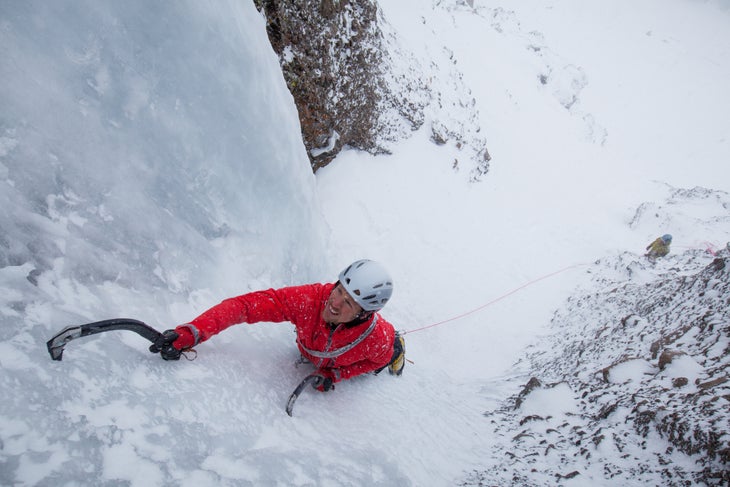
Climbing helmets are good at protecting against some types of impacts, but not others.
If every climber wore a helmet all the time, some would avoid life-altering brain injuries. But others would still be killed or disabled by head trauma. In early 2002, Rod Willard, an accomplished ice climber, was belaying behind the Fang in Vail, Colorado, when a block of ice estimated at 400 pounds broke off and hit him in the head. He was wearing a helmet, but he died instantly.
Rick Vance, technical information manager at Petzl America, explains that climbing helmets are considered Category 2 personal protective equipment, because they can’t guarantee protection against all risks they’re designed for. “A helmet can protect you against a golf ball–sized falling rock easily, but it cannot protect you from a microwave-sized block traveling at terminal velocity,” Vance says. “They’re called death blocks for a reason.”
Smart climbers are aware of helmets’ limits, and they focus more on avoiding blows to the head than fending them off with a thin skin of plastic and foam. Simple steps like avoiding climbing under other parties and placing protection frequently to avoid long falls will do much more to prevent head injuries than any helmet can.
There are even a few rare instances where helmets will increase your chance of injury: For example, it’s possible you could choke on the chinstrap if wedged into a chimney or crevasse after a fall. Straps on construction hard hats are designed to break for this reason, but climbing helmets are different—they have to stay on during a tumbling fall, and the straps are tested under load not to slip or break.
A less obvious hazard is what’s called risk homeostasis, the theory that says humans take more chances when they feel more protected. If donning a helmet entices you to attempt a 5.11 X face climb, are you really any safer?
In fact, it’s very difficult to prove that climbing helmets save lives at all, despite many anecdotes suggesting they do. On its website, Petzl has collected stories from climbers who swear helmets saved their lives. Reading these accounts, and looking at the photos of the busted helmets, you could easily conclude these climbers would be “dead for sure” if it weren’t for that trusty lid. But would they? Would a helmet have prevented Rodden or Barnes’ concussions?
“The answer is nobody knows,” says Christopher Van Tilburg, a mountain rescue and wilderness medicine expert who has worked for 14 years as a doctor at an emergency clinic on Mt. Hood in Oregon. “And the reason nobody knows is we can’t do a randomized, double-blind study on people wearing helmets.”
Numerous studies have shown that ski and bike helmets reduce the severity of injury in certain types of crashes. And though the data cannot prove that helmets save cyclists’ lives—because it’s impossible to say with certainty that a person would not have lived if he didn’t have a helmet—the fact that a very high percentage of fatal cycling accidents involve head injuries, and that most of the cyclists killed are not wearing a helmet—well, that’s a compelling set of statistics.
In 2007, the British Mountaineering Council surveyed nearly 500 climbers who had suffered head injuries, from minimal to severe. It concluded, “Wearing a helmet significantly reduces the chances of suffering a severe or major head injury: Non-helmet-wearers [were] more than twice as likely to suffer a severe head injury than helmet wearers.”
“Helmets probably don’t prevent death [among climbers],” says Dr. Van Tilburg. “Rock climbers die when they take huge falls and they have massive trauma. So the question is, are helmets useful for preventing head injuries? I would say absolutely yes, they are. The bigger the fall, the less the helmet is probably effective at preventing a concussion, and it doesn’t prevent what we call contrecoup injuries, where your brain moves inside your skull and bounces against the opposite side. But certainly, for a non-fatal fall, with a medium degree of impact, the helmet absorbs some impact.”
The influence of media and peer groups.
Magazines and other media also have a huge influence. Climbing occasionally gets letters from readers, like this one from New Jersey: “I like your magazine, but it is very troubling that so many of the photos depict climbers without helmets on. Does your organization recommend climbing without proper head gear?” The easy and obvious answer is that, no, Climbing doesn’t promote helmet-free climbing. Instead, the magazine’s photos reflect the current state of helmet use by climbers—Climbing shows the sport as it’s practiced today. In advertisements and videos, the vast majority of sponsored sport climbers and boulderers rarely wear a helmet. But imagine if Chris Sharma showed up in the next Reel Rock film slaying 5.15 routes in Catalunya with dirty-blond locks poking out from under the plastic brim of his helmet. Helmet use among sport climbers would skyrocket. No one says badass freestyle skier Kaya Turski isn’t cool because she wears a helmet. No one calls downhill mountain biking champ Aaron Gwin dorky because he protects his head. Why should climbing be different?

Every time we tie in, we make dozens of choices that could have serious consequences: Should I try this route? Do I trust this belayer or spotter? Can we finish the climb before it rains? Decision-making is integral to climbing’s appeal, and helmet-wearing is just one fraught choice in a long chain.
I believe if they thought seriously about the risks and benefits, more climbers would wear helmets. Someday, I believe, helmets will be a lot more effective than they are today. Meanwhile, like so many choices in climbing, helmet use comes down to very personal calculations. Here’s how I’ve made mine.
In more than 30 years of climbing, I’ve been hit in the head multiple times, usually while belaying ice climbs. Once I was dropped from the ceiling of my local gym, falling about 30 feet to the mat, where I rolled backward and smashed my head into a milk crate full of holds. I ended up with nine stitches in my scalp. If I’d hit the rigid corner of the crate, I might be dead. I can still feel the scar in the back of my head eight years later.
After that accident, I didn’t go full Mark Dixon and start sporting a helmet in the gym. But today, even though I know that helmets could be made stronger and safer, and although I understand it might not save my life, I always wear a helmet while leading, whether sport or trad. I am certain that I climb better with a helmet, with more confidence. And though I frequently don’t wear one for toproping or belaying, that’s changing, too. Some accidents in climbing are completely out of our control, but wearing a helmet is one easy thing I can do to gain a little power over my fate, without any special skills or effort. And I couldn’t face my wife if I chose to climb without a helmet, and then a falling rock or a tumble made me unable to earn a living, or talk to her, or feed myself.
Ultimately, it comes down to this: There are many climbs for which it’s perfectly reasonable to argue a helmet is not really necessary, but there are rarely good enough arguments for not wearing one. And so, more and more, I do.
Heads Up! How to Handle a Head Injury
Laceration
- Signs and Symptoms (S/Sx): Cuts to the scalp are the most common head injury. Bleeding can be profuse.
- Treatment (Tx): Check for more serious injury (like fracture). Firmly apply a bulky dressing. Consider tying the hair across the wound to act as a makeshift stitch. Apply ice to control swelling, if possible.
- Evac? No
Skull Fracture
- S/Sx: You find a depression or obvious crack, discharge from the ears or nose, or black and blue around eyes or ears.
- Tx: Apply diffuse rather than direct pressure to stop bleeding (flow can relieve build-up and pressure in the skull). Stabilize spine and monitor airway, breathing, and circulation.
- Evac? Yes
Closed Head Injury
- S/Sx: If trauma causes brain swelling inside the skull, the brain becomes compressed. Did your partner lose consciousness? Watch for headaches, personality changes, altered vision, and dizziness.
- Tx: Manage airway, breathing, and circulation. Wake up every few hours to assess level of consciousness.
- Evac? Yes
In the days and weeks following head trauma, watch for symptoms indicating concussion: concentration and memory trouble, irritability, personality changes, light or noise sensitivity, problems sleeping, and depression.
Who Wears Helmets? Estimated Use by Climbing Discipline
- Bouldering: <1%
- Indoors: <1%
- Sport: 35-50%
- Outdoor toprope: 45-55%
- Trad/multi-pitch/big wall: 65-85%
- Alpine/mountaineering: 90%
- Ice:>95%
Sources: “Helmet Use Among Outdoor Recreational Rock Climbers Across Disciplines: Factors of Use and Non-Use,” By Kevin Henri Soleil, 202; author field observation.
The post Why Do So Many Climbers Not Wear Helmets? appeared first on Climbing.
]]>
Climbing in the Laramie Mountains? It's not for the faint of heart.
The post Dirty Dingus McGee and the Reese Mountain Gang appeared first on Climbing.
]]>
Dingus McGee had sent me written directions and three separate maps to Reese Mountain, but when we drove onto the Vale Ranch in Wyoming’s Laramie Mountains last September, already layered in dust from 15 miles of dirt roads, we quickly lost our way. A maze of ranch roads twisted through the grass like Land Rover tracks across the African veldt. In the distance, studying Dingus’ photos, we recognized the long ridge of Reese Mountain, where he and his posse have put up about 200 routes during the past two decades. But how were we supposed to get there?
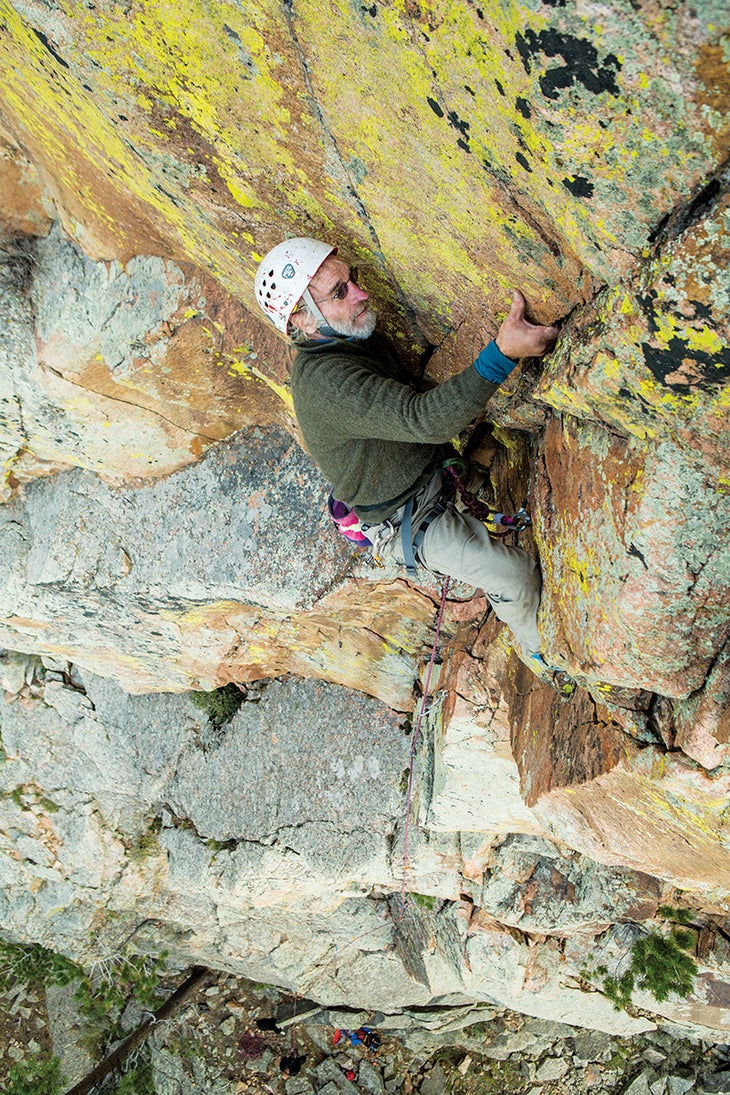
Dingus had said Reese held the best sport climbing he’d ever done—and he’s put up more new routes in eastern Wyoming and South Dakota than any man alive. His photos revealed a striking fin of gray, green, and red rock, like a granite version of Eldorado Canyon in Colorado, but with better holds and plenty of bolts. Most of the routes are in the sweet spot for sport climbing popularity: 5.9 to mid-5.12. But Reese, we’d soon learn, presents many challenges unrelated to actual rock climbing. It took us an hour just to find the trailhead.
A faint trail plunged down a slippery wet draw through aspen and scrubby oaks. In the creekbed we pushed through thickets of poison ivy with glossy, scarlet leaves. (Reese climbers, we learned later, always hike to the crag in gaiters or rain pants, and then scrub their exposed skin with soap and water before climbing.) Bear shit lay in prodigious, berry-filled piles in the path. After more than an hour of walking, we climbed over a small ridge to a view of the crags, still 500 feet up a hillside. Suddenly the wind blew so hard that we staggered under our packs, loaded with food and gear for three days.
Within five minutes of reaching the lowest cliff, looking up and wondering which line of mystery bolts would make a good warm-up, I cartwheeled into the talus as a boulder rolled under my feet. As I gingerly checked for injuries, I was approached by a wiry, slightly stooped man. He had a silver beard and tangled hair poking out from under a ball cap and wore wire-rimmed glasses and a threadbare sweater. He looked us over. “You made it!” said Dingus McGee. He sounded surprised to see us.
I was beginning to sense why Dingus and his gang had decided to spill the beans on their long-secret enclave. Given what we’d experienced before even roping up, it seemed unlikely that Reese would soon be overrun with gym climbers.
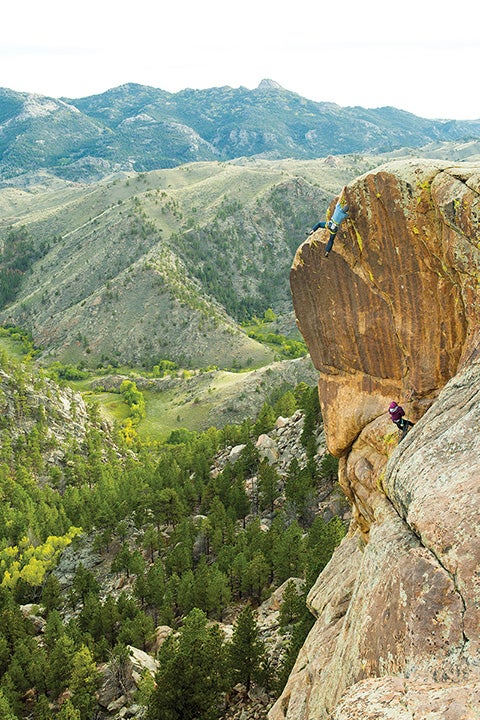
Dingus McGee, née Dennis Horning, is one of America’s most prolific and enduring route developers. (Horning adopted the nickname from a 1970 film, “Dirty Dingus Magee,” starring Frank Sinatra. It’s a long story, and Dingus is more than happy to tell it, but it’d require a thousand-word detour.) Over more than 40 years, Horning has established or freed hundreds of routes at Devils Tower, the Black Hills of South Dakota, throughout southern Wyoming, and in other states. In the early 1980s, he was a pioneer of what eventually would be called sport climbing. And he’s still at it: Last winter, at age 65, he redpointed the first ascent of a 5.12 route at Guernsey State Park, a recently developed sport area in Wyoming.
Dingus is a born raconteur, telling stories in a high-pitched, singsong drawl, and his life has given him plenty of material. Growing up in Edgemont, South Dakota, (pop. 774) just south of the Black Hills, he was a bright, smart-ass kid who got in a lot of trouble without doing much real damage. When he was 17, Horning and some friends were jailed briefly for lobbing eggs at someone they thought had just egged them. “Well, that person was the new young police officer walking to work just after dusk,” he said. “Just after the jailing, a girl that had a crush on me showed up and offered to sneak some hamburgers through the small window. I asked for a hacksaw blade instead. They let everyone out when the 10 o’clock curfew whistle blew, and we never told anyone about the bar I’d sawn through in that cell.”
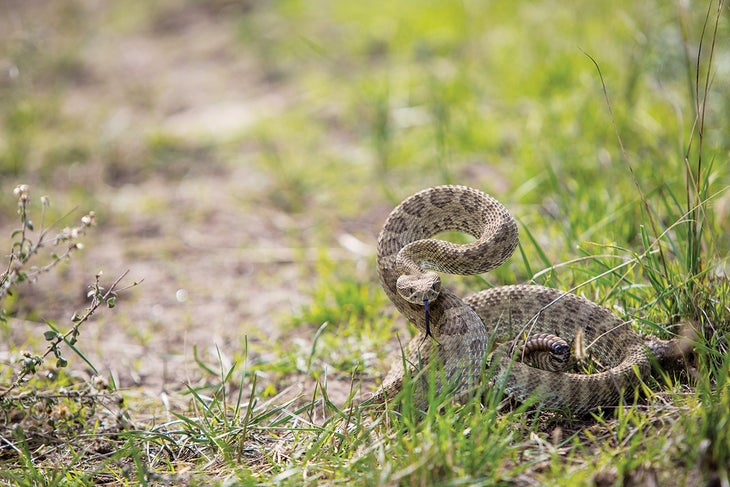
Horning discovered climbing in 1971 during a joy ride to Devils Tower on a new motorcycle. Ignoring the “Hiking Above Talus Requires a Permit” sign, he scrambled to the base of Hollywood and Vine(5.10c). It was obvious he couldn’t go farther without gear and knowledge, so he bought a how-to book at the visitor center. Back at the South Dakota School of Mines and Technology, where he was studying engineering, he asked local cavers where they bought their carabiners, and then sent an entire paycheck to Boulder Mountaineer (a gear shop in Boulder, Colorado, now closed) to order gear.
The Black Hills held the closest rock to campus, and Horning dragged friends out to the Needles, Mt. Rushmore, and Elkhorn Mountain, climbing whatever looked good. There was no real guidebook and precious few climbers in the area. Most of the routes he did were probably new.
Horning was a good athlete—he later competed in Nordic skiing and wrote mountain biking guidebooks—but it wasn’t just the physical side of climbing that appealed to him. He was an engineer and liked to make stuff. (He learned to make homebrew when he was just 14—with his parents’ permission—and at the tipi camp outside Devils Tower National Monument, where climbers used to crash in the ’80s, he constructed a bicycle-powered device to grind wheat for pancakes.) Making new routes naturally followed. “He might be the most prolific first ascensionist ever in the Black Hills, probably even more than Herb and Jan Conn [the original pioneers of Black Hills climbing],” said Brent Kertzman, a longtime climber from Rapid City, South Dakota.
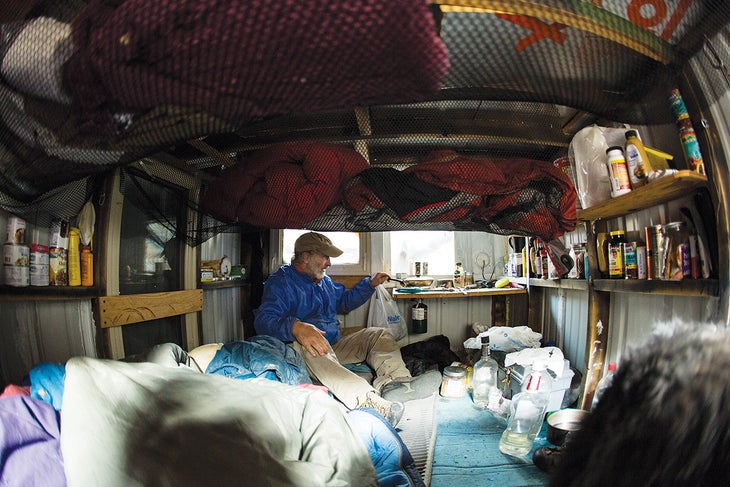
During his first year of climbing, Horning spotted a group of climbers on a pinnacle in the Black Hills. It turned out to be Tom Higgins, Bob Kamps, Mark Powell, and Dave Rearick, four of the strongest free climbers of the day. “They befriended me immediately, and the next few days I climbed with them and learned a lot, including their ideas of what would later be called climbing ethics,” Horning said. “So I learned from the traddest of the trad,” Horning said. He paused for a beat: “I guess it didn’t catch.” He also later met bouldering legend John Gill in the Needles.
Without much concern for what other climbers thought—at a time when most new routes were still established ground-up—Horning began experimenting with rappelling to place bolts. “Doing new routes for me is a creative undertaking that makes use of several of my skill sets,” Horning explained. “But by the time I met Kamps and that group at the Needles, I had my own ideas as to what constitutes safety and fun. When you climb a new line, you are in control of the outcome, and I had several convictions of what I wanted out of a climb. Boldness and runouts never had much merit for me. If I did a climb, I wanted some 99.9 percent likelihood I would be around for another.”
Horning said he “came out of the closet” about his top-down tactics in 1981, and in 1983 he rap-bolted the second pitch of Everlasting (5.10c) at Devils Tower, while doing the first ascent. “Locals were furious,” he said. “But I put up a third of the routes at the Tower. I was more local than anyone!” (In fact, Horning put up or freed about a quarter of the routes in the Devils Tower guidebook, including many favorites: Assembly Line (5.9), Burning Daylight (5.10b), One-Way Sunset (5.10c), Mr. Clean (5.11a), the first free ascent of McCarthy North Face (5.11a), and, of course, Everlasting.)
“Back in the ’70s, I was a ranger at the Tower, and Dennis was on the South Dakota Climbing Team, which means he was on unemployment for the summer,” said longtime partner and friend Frank Sanders (see Under the Devil’s Spell). “Dennis definitely raised free climbing standards on the Tower.” Horning and his ex-wife, Hollis Marriott, popularized climbing at Devils Tower and the Black Hills through a long-running series of guidebooks, published under the pen names Dingus McGee and the Last Pioneer Woman. The Tower guide went through at least 14 editions.
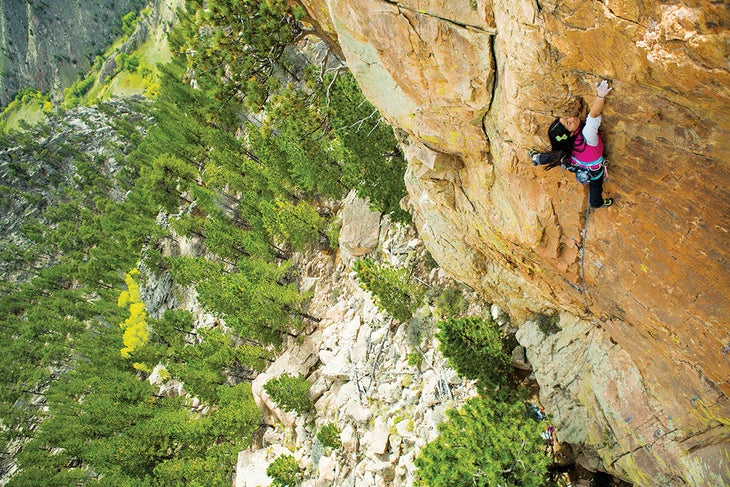
Kertzman climbed many new routes with Dingus in the Black Hills, including some controversial rappel-bolted climbs in the early 1990s. Later, Kertzman said, “I decided there were better places to play that game, but Dennis would say, ‘Let’s stir up the hornet’s nest. Let’s see how long these routes will stand before they get chopped.’
“I call him the Howard Stern of southeastern Wyoming climbing,” Kertzman added. “He’s not worried about what other people think. And he was a harbinger of sorts—he understood climbing’s evolution.”
Dingus had enrolled in college to escape the draft and Vietnam, and he eventually chose mechanical engineering for a degree. However, he said, “Before I had finished three semesters working on my master’s, I discovered climbing. My foggy career goals soon became definite: I would rather be climbing than working at an engineer’s desk.” (He eventually did get a master’s and worked on a Ph.D., with the thesis topic “Using Lagrangian Coordinates to Model Shock Wave Propagation in Snow.”) Now he works just enough to get by, doing home remodeling and other building projects. Mostly he climbs.
In recent years, Horning and partners have developed dozens of routes in Harts Draw, a side canyon of Indian Creek, Utah; more than 100 routes at Guernsey, the lowest elevation and warmest winter climbing area in Wyoming; and about 60 routes on the limestone of 4 Stories, a summertime crag in the Snowy Range west of Laramie. Horning found Reese in the 1980s while perusing maps of the Laramie Mountains for mountain biking routes. He saw a cluster of contour lines and thought, I gotta check that out!
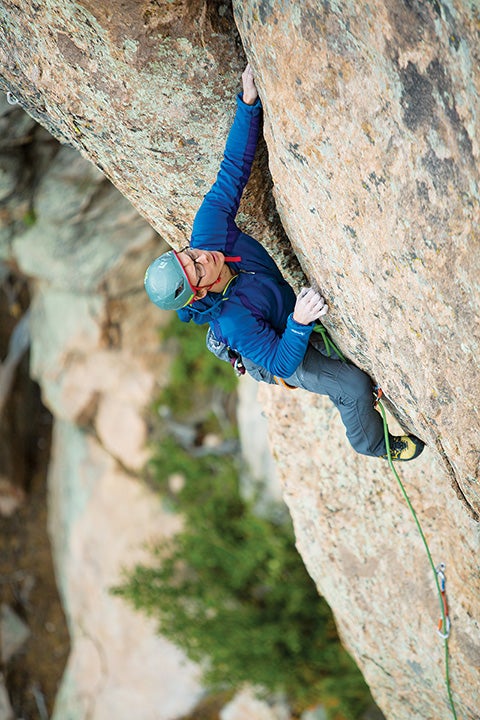
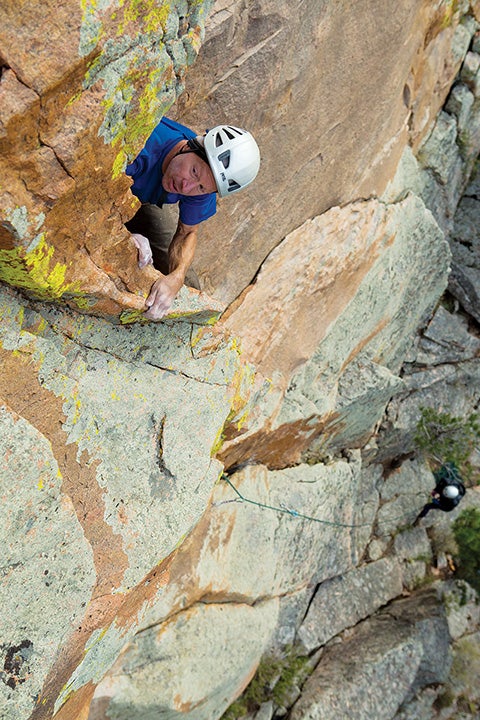
The southwest ridge of Reese Mountain is a granite fin that rises about 1,400 feet above winding Ashley Creek. Both sides of the ridge and its tip are laced with climbs. Because of the different sun and wind aspects, and who-knows-what geological influences, the rock and the climbing vary from crag to crag along the ridge.
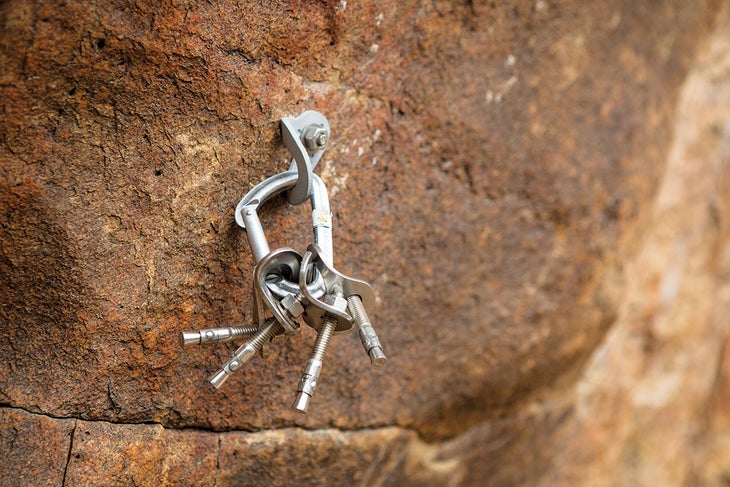
The Hightower, at the low end of the ridge, has tricky sidepulls and edges, with a second tier of routes up an overhanging headwall. The Curl, around the right side, has chickenheads and incut edges. On the opposite side is the Amphitheater, a flat plane of gray overhanging rock. Higher up the ridge, Douglas Park, usually accessed by rappel from the ridge top, has overhanging slopers. Sherard Tower, near the top of the fin, has longer routes with slabs and roofs. Bolts are plentiful, and Horning and other climbers are rebolting their old routes to turn them into pure sport climbs or to reduce the possibility of ledge falls and other hazards. “We’ve crossed the River Styx between trad and sport,” Horning laughed. “I don’t want this to be a stick-clip area.”
“I’ve climbed at a lot of places, and steep, featured granite is pretty hard to find,” says Mike Friedrichs, a Salt Lake City climber who has been coming to Reese and developing new routes since about 1993. “City of Rocks comes the closest to what Reese is like. But it is coarse at times and doesn’t have the small-grain compactness of Reese granite.”
Like Friedrichs, many Reese climbers are part of a Wyoming diaspora—climbers who once lived or studied in the university town of Laramie but migrated elsewhere for work, or just to escape the wind, and now come back for homecomings at Reese and other favored crags. Ryan Laird, who now lives in Fort Collins, Colorado, says, “The remoteness and ruggedness of Reese provide a sense of solitude. The different sections of the ridge offer a huge variety of rock shapes and climbing styles: featured technical faces, four-pitch slabs, steep roofs, and even a few splitter cracks. It’s a special place.”
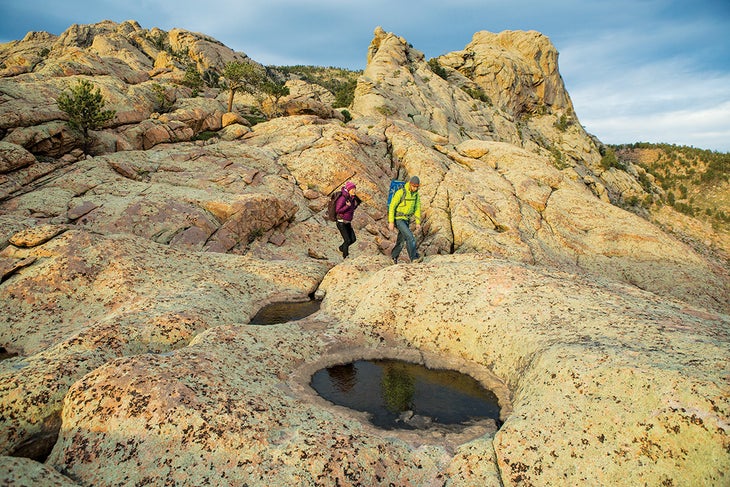
On our second day at Reese, we headed for The Curl with Friedrichs, Laird, and Anne Yeagle, another Reese climber now living in Utah, seeking the morning sun and some shelter from the sharp knife thrusts of Wyoming wind. We sampled a new route that Laird had just completed, brushing drill dust off the holds. Yeagle and Friedrichs led two 5.12a pitches, cranking positive edges over bulges. I climbed several 5.10 pitches that would be three stars anywhere in Colorado. Horning showed little inclination to shoe up. “That one’s beyond my hanging-on ability,” he said at one point. Instead, he directed traffic, telling the crew which routes they ought to climb for photographer Andrew Burr.
After lunch, I tried and failed to find the right sequence for the hand-jam and iron-cross crux of a wild 5.11 called Sex at Noon Taxes. Dingus, a fan of puns and palindromes, had coined that name. He is also prone to practical jokes and pranks. Once, when he felt a partner was lingering and chatting with other climbers for too long near the top of Devils Tower, Dingus rappelled off without him. Kertzman said every climbing trip he did with Dingus had a theme, usually involving flatulence or sex or human activities too perverse to describe in this magazine, upon which Horning would riff for days, sometimes in nasty ways, like a kid who doesn’t know when to stop teasing.
“I learned a lot from the guy, and he’s been inspirational, but in a kind of tormenting way,” said Kertzman. “He’s more of a tormentor than a mentor.”
Zach Orenczak, who has been climbing at Reese since 1998 and is about to publish a guidebook to the Laramie Mountains (see Beta section), said of Horning, “The steep routes of Reese were built by the blood, sweat, and tears of his many younger partners. Reese is Dennis’ Shangri-La, and when he’s out there, he’s the king. He rules with an iron fist and incredible punctuality. If you are not ready to hop in his van the moment he’s ready to roll, he’ll steal your route and name it Zachoff [Rendezvous Buttress, 5.11a]. At least he gives credit where credit is due.”
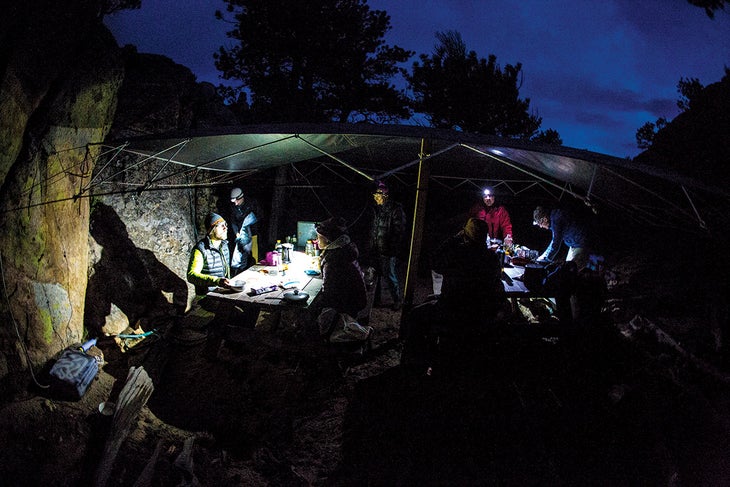
“Dennis can be irascible, petulant, and loves to argue,” Friedrichs said. “Some people just don’t want to be around him anymore. But Dennis also has a really caring side to him. One time a woman in Laramie was in an auto accident and was hurt pretty badly. Dennis showed up at her house and did chores for a couple of months until she was back on her feet. He’s given away more first ascents than most people ever have. I hadn’t known Dennis very long when he asked me if I wanted to do a first ascent at Devils Tower. He had cleaned the crack of poison ivy and placed a bolt, and he gave me the lead. I’ve seen him do that for a lot of people.
“Dennis is also interesting,” Friedrichs added. “He calls me at least a couple times a month to talk about string theory or nutrition—once, a long discourse on welding. It made me realize that you don’t have to stop learning when you get older.”
One veteran Wyoming climber calls Horning a cantankerous know-it-all. Another calls him a cherished friend. To many, it seems, he is both.
“One of my favorite stories is actually recounted by Dennis himself,” Laird said. “The family that lives next to Dennis once told their 6-year-old that he needed adult supervision to play outside. The kid thought about it for a minute and then asked, ‘Is Dennis an adult?’”


Late in the day, we hiked to the top of the southwest ridge, and Friedrichs, Yeagle, and I rappelled off the far side into Douglas Park. I climbed back out via Hanging of Yellowstone Kelly, a superb 5.11b with sequential cruxes between good rests. Friedrichs led the appropriately named Aeolus (5.12b), and then belayed on top with his coat snapping in the wind. “One time I couldn’t even throw the rope down to rappel to Douglas Park, the wind was so bad,” he said later. “I had to tie a pack to the rope to get it to go down.” The night before we arrived at Reese, the wind destroyed a brand-new tent.
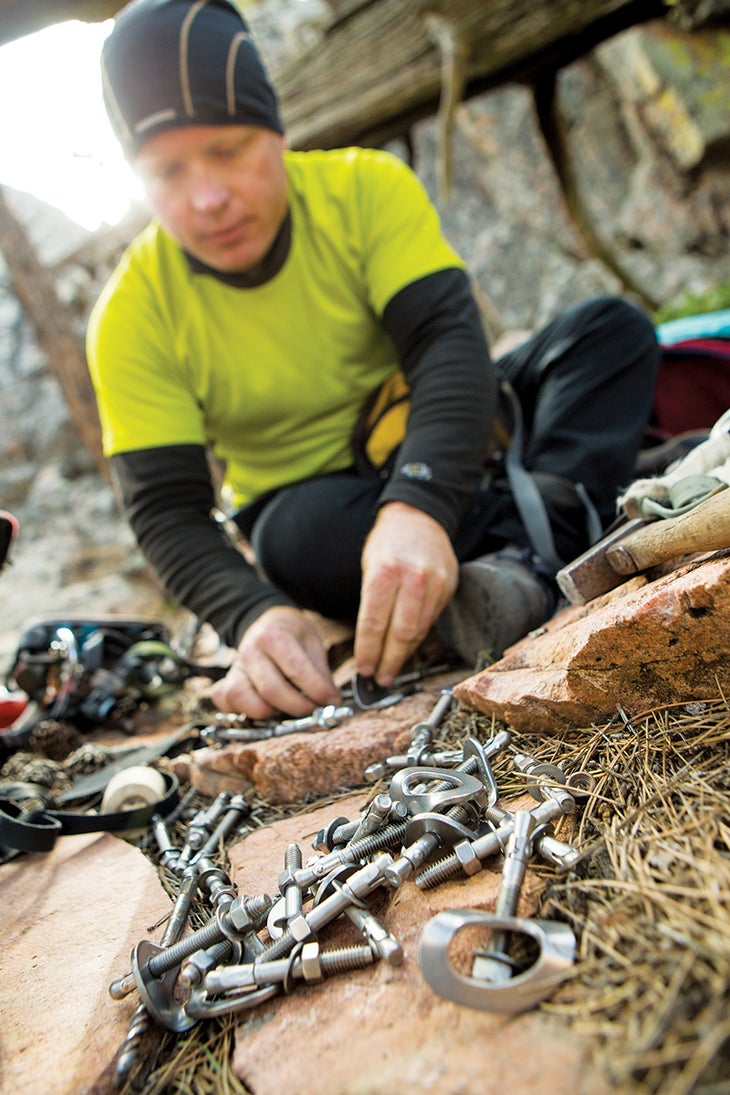
“Is it always like this?” I asked Horning, hunched in the lee of a boulder.
“May and September are windy,” he said. “July is too hot. June and August are good.”
Reese is a bastion of Type 2 fun—activities that seem fun only after they’re over and you’re telling stories about them in the bar—which is undoubtedly part of the appeal for certain climbers. “I have had too many Reese experiences to count,” Laird said. “I have been baked, frozen, wind-whipped, and mosquito-bitten. I have experienced rain that soaked through my rain gear to my underwear, and forded flooded streams. I have seen deer, elk, bighorn sheep, rattlesnakes, and lynx. I’ve skinny-dipped and stomped out a brush fire, but not at the same time.”
In July 2002, Friedrichs and Yeagle hiked into Reese late at night during a fearsome lightning storm. “We sat on the rocks and watched an amazing show,” Friedrichs recalled. “The next morning there was a faint smell of smoke. Anne and I hiked around and climbed two pitches on Hightower. On top of the second pitch we saw smoke to the northwest. We headed back to camp and watched for about 15 minutes until flames came over the ridge two or three miles away. The flames were leaping from tree to tree. We packed up and left as fast as we could, and the fire eventually burned almost all the way around Reese. We were lucky the wind didn’t pick up.”
Rattlesnakes have been discovered at least twice at Camp Dingus, Horning’s favorite campsite atop the ridge. “We really like rattlesnakes, but not at camp,” Friedrichs said. “Dennis made a snare from a stick and a piece of twine, caught the snake, and put it in a five-gallon bucket. We put a lid on it, and Anne rappelled off the west side with the bucket clipped to her harness so she could let the snake go.”

In such an environment, it’s not surprising the Reese regulars do their best to ease the burden. When climbers are occupying Camp Dingus, hidden in a sandy patch amid the convoluted rocks on top of the ridge, a camouflage tarp keeps off the rain and sun, and a filter system provides drinking water from potholes filled by storms. The Reese crew stashes ropes and gear in strategic locations around the crags, and they stock mouse-proof thrift-store suitcases with cooking supplies and other necessities for return visits. This way, they can hike in for several days of climbing with a daypack weighing only 10 or 15 pounds. Entering Camp Dingus after scrambling up a gravelly gully and threading through rock passageways feels like you’ve stumbled into a guerrilla hideout. You expect to encounter armed sentries and trip wires.
Horning estimates he has spent more than a year of his life at Reese. One time he stayed there 18 days straight. Understandably, he’s a bit possessive. Twice, most recently in 2005, billionaire Pat Broe, who owns Notch Peak Ranch just to the north of Reese, tried to negotiate a land swap with federal officials that would have moved about 5,000 acres of land, including Reese Mountain, into his holdings. Horning helped rally opponents to the deal and kept Reese in public hands.
On day three the wind had lessened just a bit, and we walked around to the Amphitheater for two overhanging classics: Twenty Red Lights (5.11c) and Fading Into My Own Parade (5.12a/b). Looking up at the latter, Friedrichs said, “That route’s all 12b before you get to the 12b.” In late morning, Horning got inspired to climb. After a couple of us had done a long, tricky 5.10, Horning laced up, tied in, and floated the route. At 65, because of exercise-induced asthma, he no longer ski-races or bikes, but he’s plenty fit. “If you’re going to hike with Dennis, you better put your track shoes on,” Friedrichs said.
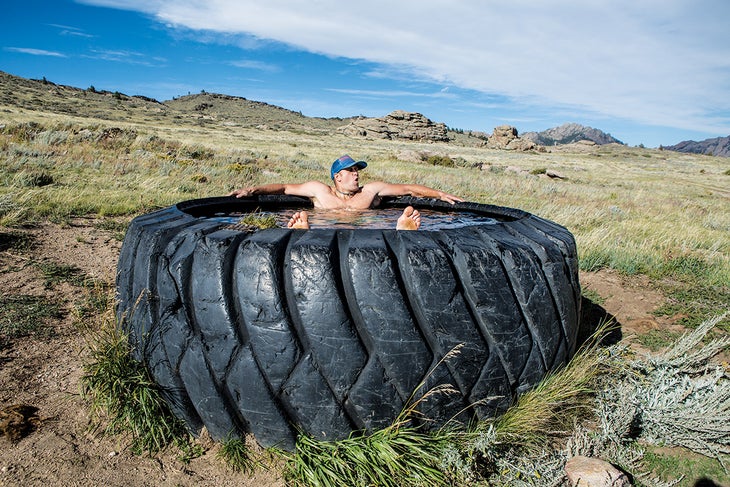
The Amphitheater had obvious room for new routes, likely very hard, but I wondered who would do them. There’s not much harder than 5.12b at Reese, and not much easier than 5.10. Given the isolation, the short season, the snakes, and the wind, even this article and the new guidebook are unlikely to lure hordes of sport climbers. Which will leave Reese Mountain to those who love it.
“Dingus first invited me to Reese about 15 years ago when he saw me climb the Left Torpedo Tube (5.10+) at Vedauwoo blindfolded,” said Laird. “Apparently he figured that if I liked climbing that much, then I would love the climbing at Reese. I’ve been trying to keep up with Dingus ever since. Reese is unique, and I love sharing the experience with other climbers and seeing how the place affects them.”
In early afternoon, facing a long drive home, I started to hike out from Reese alone. A rattlesnake buzzed by my feet as I followed the faint path up Duck Creek, and I got lost halfway to the car. But I knew I was one of those climbers who’d soon find his way back. //
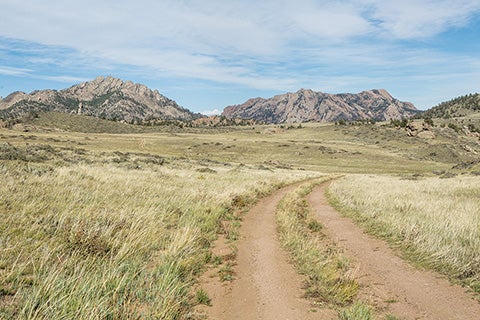
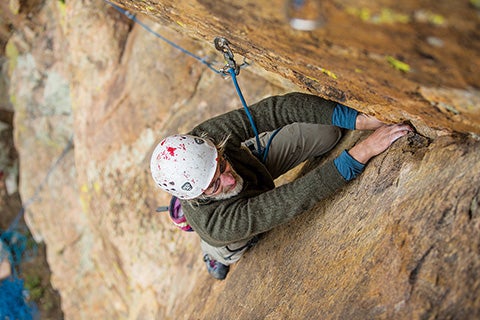
The Dingus Dozen
The Reese Mountain Gang’s all-time favorites
(Commentary by Dennis Horning)
Red Mite (5.9+) The CurlGreat warm-up with chickenheads, bulges, rests, and an optional 5.10 finish.
Block Party (5.10c) Hightower150 feet of fun.
Rope Tricks (5.10d) HightowerPinches and gastons rule over crimps.
Mrs. Radical (5.11a) Douglas ParkHow good are you at slopers?
Ride Steppenwolf(5.11a/b) HightowerSidepulls, edges, and pinches for 140 feet on the upper wall.
Hanging of Yellowstone Kelly (5.11b) Douglas Park“The best 11b in all of Wyoming.”
Sport Trindleberg(5.11b) The CurlA steep wall to a delicate hip-shifter roof exit, with more fight to come on the face above.
Twenty Red Lights (5.11c) The AmphitheaterAn overhanging face not yet flashed by a Vedauwoo climber—they always go for the crack.
Gamma Bursts(5.11c) HightowerBurly moves on a double-overhanging dihedral.
Aeolus (5.12B) Douglas ParkLeft-trending crack and corner system. Spectacular stemming and arête moves.
Down Converter(5.12a) The CurlDifficult stemming finishes with a crimp at the exit shaped like a light switch in the “on” position. The first 80 feet to an anchor on the right is 5.10+ and excellent.
Fading Into My Own Parade (5.12a/b) The AmphitheaterFading will happen when your hands can’t feel to grip, toes too numb to step, and your boot heels are wanderin’. (Apologies to Bob Dylan.)
Beta
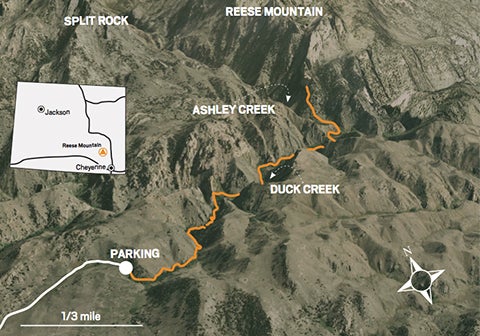
Get there Reese Mountain is in the Laramie Mountains, west of Wheatland, Wyoming. Allow about four hours of driving from Denver or eight hours from Salt Lake City. The last hour of the drive is along the gravel Tunnel Road and two-tracks across Vale Ranch; high-clearance vehicle recommended. The hike from the parking area at the top of Tony Gulch takes about 1.5 hours; the faint trail goes down Tony Gulch to Duck Creek and follows this to the confluence with Ashley Creek. Download GPS tracks for the drive across Vale Ranch and the hike here. Maps and other approach information are at mountainproject.com. Allow a few extra hours for the driving and hiking route-finding on your first visit.
Guidebook Zach Orenczak and his wife, Rachael Lynn, will release High Adventure in the Laramie Range: A Climber’s Guide ($50, extremeangles.com) in August. The book will cover Reese and many other crags accessed by Tunnel Road.
Camping There are good sites in the meadow below the crags (make sure you’re above private land at the junction of Ashley and Duck creeks; water may be hard to find in late summer). You can also camp on top of the crags; potholes hold water year-round (filtration mandatory).
Season The Reese Mountain window extends from May through September, with June and late August typically offering the best climbing, without being too scorchingly hot. Some roads may be difficult to pass in early season. Parts of the Laramie Peak Wildlife Habitat Management Area, including the approach to Reese Mountain, are closed to public access December 1 through April 30 to protect breeding bighorn sheep.
This article was originally published in Climbing in 2014.
The post Dirty Dingus McGee and the Reese Mountain Gang appeared first on Climbing.
]]>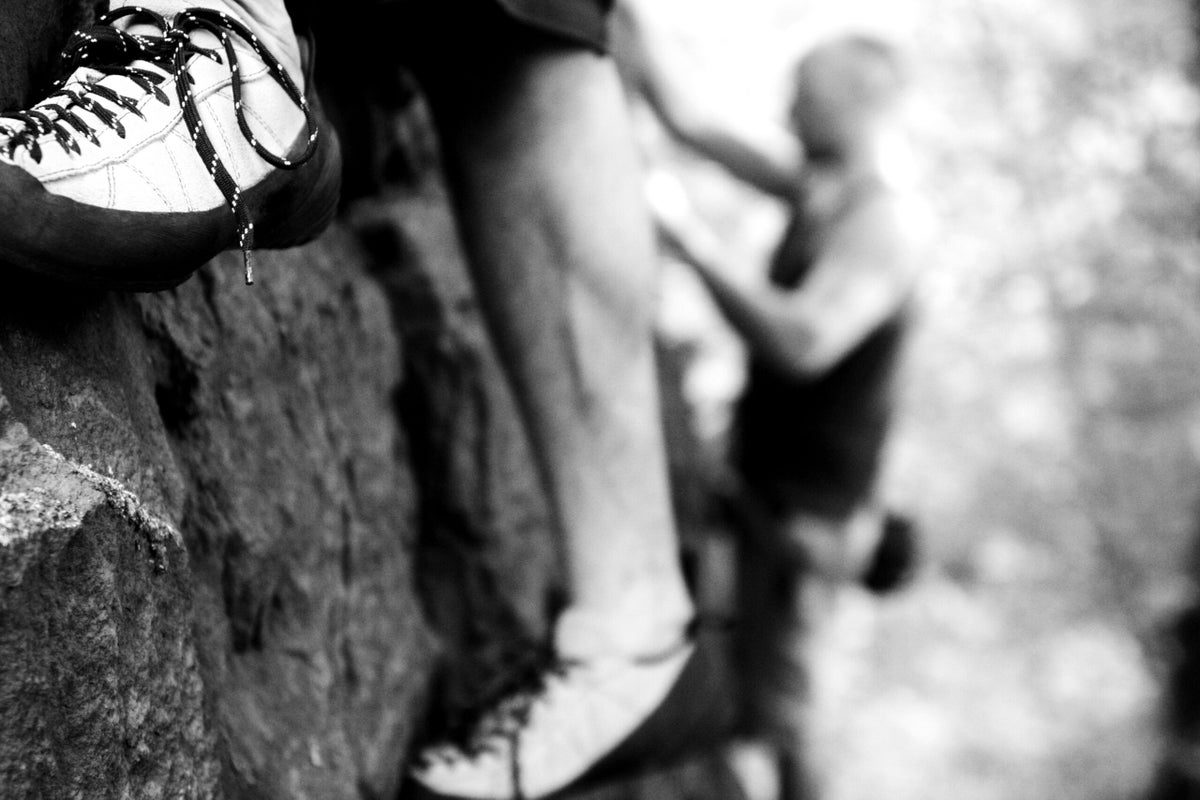
We spot boulder problems. Sometimes we spot climbers before they clip their first piece of pro. Now imagine spotting a climber falling 60 feet.
The post A Mis-clipped Anchor Leads to a 60-foot Grounder—And a Life Saving Spot appeared first on Climbing.
]]>
Climber: Douglas Kern
Location: Staunton State Park, Colorado
Date: August 23, 2014
The Scene
Asha Nanda, 21, had been introduced to climbing at a Christian leadership program in the Adirondacks. During a trip to Colorado, she and several other climbers hiked up to the Tan Corridor, high in a forested gully in Colorado’s newest state park. Douglas Kern, then 25, had just met Nanda the day before; he was one of the more experienced climbers in the group. In the afternoon, Kern led Reef On It! (5.10-), a vertical, seven-bolt sport climb. He left a rope running through quickdraws clipped to the anchors so the rest of the group could enjoy a toprope.
Nanda was the last climber to do the route. Before starting, she borrowed one of Kern’s thin Dyneema slings and girth-hitched it to her harness; she planned to use this sling to clip in at the anchor, thread the rope, and then rappel. Kern’s slings were rigged as alpine draws, with a wrap of tape cinching the sling tight next to one of the carabiners so it wouldn’t shift around.
When Nanda reached the top of the route, 60 feet above the ground, she clipped one of the anchor chains with the sling hitched to her harness. Although she was new to outdoor sport climbing, she had rehearsed anchor cleaning in a gym, and had run through the steps with one of her climbing partners earlier that day. She leaned back and fully weighted the sling connecting her to the anchor to test it, then yelled “off belay” and began untying the figure eight at her harness, preparing to thread the rope through the anchor. “I was very focused on checking and rechecking each step, and this process took approximately two to three minutes,” she says. Suddenly she heard a scream and saw the rope falling in loops below her. Then she realized the scream was her own and she was plummeting through the air.
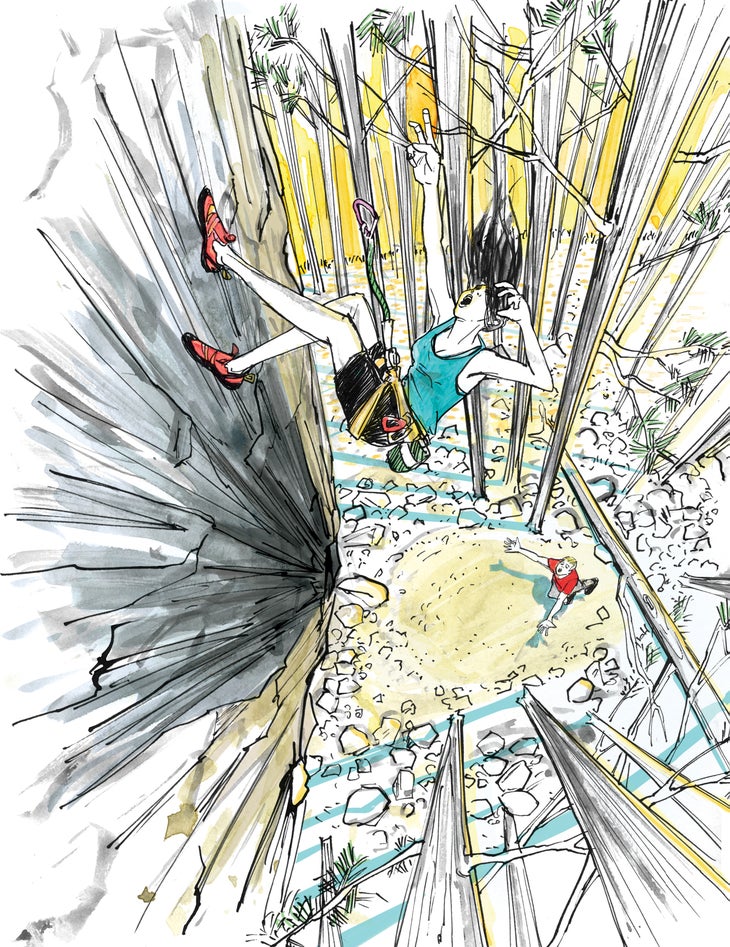
The Response
Unbeknownst to Nanda, the single sling she’d used to clip the anchor had been compromised, either before she hitched it to her harness or while she was climbing. A loop of the sling must have slipped through the gate of the carabiner that was taped at one end, so now two strands of sling were clipped through the same biner. Although difficult to visualize, this creates a very dangerous situation similar to cross-clipping two loops of a daisy chain—in effect, when Nanda weighted the sling, only the wrap of tape around it secured her to the anchor. The beefy climber’s tape held her weight until she had completely untied and only failed then, leaving the carabiner still clipped to the anchor bolt and the now-useless sling hitched to her harness. The tape fluttered to the ground after the falling climber.
Startled by Nanda’s scream, her belayer, Julie MacCready looked up to see her plunging toward the ground, the rope looping below her. There was nothing she could do to stop her. Kern had just lowered off a nearby climb and was walking down the gully when he heard Nanda yell. Amazingly, he had no doubts about what he would do next.
“I once saw a dude fall in the Adirondacks when we were ice climbing,” he explains. “He fell 20 feet and landed on the ground right next to me. I said to myself right then, ‘If I ever see that again, I’m going to catch the person.’”
Nanda weighs about 125 pounds, and Kern is 6’ 2” and weighs 190 pounds. He had lifted weights throughout high school and college and practiced karate. As he saw her fall, he vividly remembers thinking, “She’s so small, I’ll catch her—it’ll be no problem. I’m going to stop this fall.”
No more than two seconds elapsed between Nanda’s scream and her impact, but Kern remembers that she seemed to be falling “really slowly.” He stood at the base of Reef On It!, planted his feet, and stuck his arms out in front of him, like a man about to catch a medicine ball in the gym. Nanda fell into his arms and slammed onto his chest, then ricocheted onto the ground, where she bounced “a foot or two” off a single narrow strip of dirt amid a sea of boulders and scree.
Flat on her back, Nanda looked up at her friends and said, “What happened?”
Both Kern and Jennifer Lee, another friend in the party, had wilderness first aid training and began to assess Nanda’s condition. MacCready called 911, and another climber ran down the mountain to direct rescuers to the scene. Despite the horrendous fall, Kern and Lee could find no injuries, but when rescuers arrived she was shaking and her blood pressure was falling. Rescuers carried her out of the gully and called for a chopper. She arrived at the hospital two hours after the fall. After seven hours of tests, Nanda was released—every test and scan had come up negative.
Nanda quickly returned to climbing, but says her accident taught her several crucial lessons, including to use her own gear, avoid taped “alpine draws,” and always back up her anchor. Also, she says, “If you’re new to climbing, advance cautiously and with respect to the risks.” She now lives near the Red River Gorge in Kentucky, studying nursing and volunteering for the local fire department.
While Kern’s actions undoubtedly were heroic, he was lucky too. The impact of Nanda’s fall could have seriously injured him or even killed them both. The great difference in the two climbers’ statures enabled him to absorb the blow. Kern also had prepared himself mentally for this day after witnessing a previous groundfall, and his self-confidence and desire to succeed boosted his ability to stand tall.
Kern, who is now living in New Zealand and working for an arborist, credits God for helping him save Nanda: “I think He wanted that girl alive.” Asked if he would do the same thing if he witnessed another falling climber, Kern says, “For sure! If I got a bruise, big deal. She didn’t die. Of course I’d do it again.”
Survival Tip: Give Accurate Directions
Write down or review the information you want to communicate before calling rescuers, including your location (without relying on route names, if possible), your name and number, and the patient’s status. “Rescues are often delayed by panicky callers that are unable to give a location to rescuers,” Simon explains.
The post A Mis-clipped Anchor Leads to a 60-foot Grounder—And a Life Saving Spot appeared first on Climbing.
]]>
On December 5, 2011, in Pinnacles National Park, California, Lars Johnson found his legs crushed by a 2-ton boulder. His fast-acting partners saved his life.
The post From the Archive: When a Climber is Pinned by Two-ton Boulder, Friends Launch Remarkable Rescue appeared first on Climbing.
]]>
Climbers: Lars Johnson, Josh Mucci, Brad Young
Location: Pinnacles National Park, California
Date: December 5, 2011
The Scene
Three men had met because of a common interest in new routes in the obscure back corners of Pinnacles National Park, southeast of San Francisco. Before the day ended, each would help save another in extraordinary ways.
Lars Johnson, then 62, was a painter and illustrator who had done many new routes on the park’s rhyolite breccia, a well-featured but sometimes loose stone made from volcanic mudflows. Two decades earlier, Johnson had fallen 70 feet from an attempt at a new route, breaking his leg in two places. His drill bit still projected from the rock. Now he wanted to show this line and others to two younger climbers: Brad Young, then 49, author of the Pinnacles climbing guidebook, and Josh Mucci, then 30, a California climber passionate about adventurous new routes.
In late morning they reached a steep, narrow gully leading to a belay ledge below the line where Johnson had fallen. They started scrambling up the gully. Near the top, a boulder choked the path. Mucci led the way up a slot on the right side, balancing with his left hand against the boulder.
The teardrop-shaped block, about three feet in diameter, suddenly shifted and tumbled into the six-foot-wide gully, threatening to crush Mucci’s left arm and chest. Instantly, Johnson reached up with his right arm and pushed Mucci hard to the right and out of the way. Young dove to the left. Johnson had nowhere to go. The boulder rolled directly onto him.
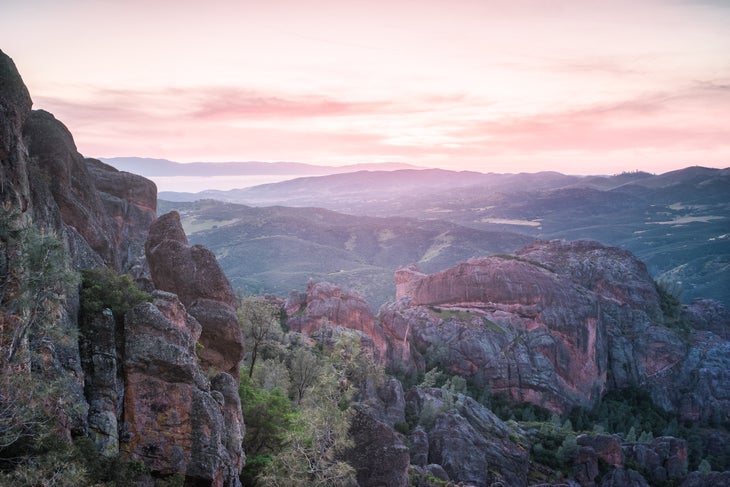
The Response
Mucci and Young wrapped their rope around the boulder and tied it off to a tree, hoping to prevent further rolling. Throwing their weight against the rock, estimated to weigh two tons, they were able to move it an inch or two, freeing Johnson’s twisted left leg. But his right leg was trapped up to the hip.
Young, who knew the area best, ran for help. He reached the normally desolate West Side parking area after a half-mile bushwack and a mile of trail to find, quite luckily, park rangers and a trail crew. They radioed for more help and a helicopter, and ranger Mark LaShell and two trail crew left for the accident scene almost immediately, with Young leading the way.
Back at the boulder, Mucci dug at the stony ground for about 45 minutes, despite a badly injured wrist. Finally, Johnson was able to squirm out with Mucci’s help. Johnson had a compound fracture in his right leg and many other injuries. “I got him seated, splinted his broken leg using the rope and a leash from a hammer, and elevated his leg,” Mucci says. More than two hours after the accident, a helicopter dropped a nurse and paramedic on a nearby ridge, while other rescuers cleared a path down which they could lower Johnson in a litter. In fading sunlight, the chopper came in “right off the deck,” Mucci says, and then short-hauled Johnson to the parking area for a transfer to an air ambulance.
As the professionals took over, both Young and Mucci ended up making their way to the parking lot alone, very conscious of how close the margin had been.
“Had it just been me there with him, Lars would have been dead,” Mucci said. “Had Brad stayed and I went down for help, Lars would have been dead. If the ranger team hadn’t been there, he’d be dead. It all had to come together. And it came down to 15 minutes.”
Even though time was critical, Mucci and Young took crucial steps that professional rescuers recommend: They secured the scene to prevent further injuries and prepare the way for a rescue; they made a plan and effectively used the tools they had; and they assigned the right people to each job—Mucci, who had wilderness EMT training, tended to Johnson, and Young, the guidebook author, went for help and led rescuers to the victim.
Johnson mostly recovered from his injuries and returned to painting (studiolarsjohnson.com) and exploring California’s mountains. Josh Mucci says he experienced PTSD that affected him for several years. “In gullies, with loose rock, I’d just burst into tears,” he explains. Mucci now lives in San Diego, and Brad Young lives in the northern Sierra foothills. Both still develop new routes. But not on that obscure backcountry wall in Pinnacles. All three men have sworn they’re never going back.
Survival Tip: Take Care of Yourself
“Making certain that you and your partner are safe and secure is always rescue step number one,” Simon says. This includes a good anchor and adequate protection against rockfall, foul weather, or falling temperatures. “You are no good to your partner if you get hurt or incapacitated.”
The post From the Archive: When a Climber is Pinned by Two-ton Boulder, Friends Launch Remarkable Rescue appeared first on Climbing.
]]>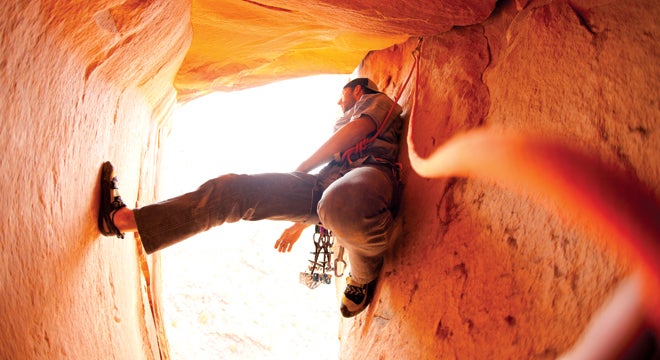
Terminally pumped? Follow these tips to achieve a restful stance on vertical rock, steep caves, corners, and more.
The post Expert Advice for Advanced Resting Tactics appeared first on Climbing.
]]>
The best way to maximize your staying power for enduro-packed routes is by resting more often and more efficiently during the climb. You may do endless training laps for stamina, but learning to cop strategic rests mid-route is more likely to win you the onsight on any terrain.
Vertical Rock
Your legs are much stronger than your arms, so look for stemming opportunities to relieve your fingers and forearms throughout a route. Corners are the obvious places, but many times you can also stem between knobs, pockets, ribs and tufas, or other rock features on a flat wall. To rest on a face climb or arête, wrap your instep over a crystal or edge, rock onto it, and then squat onto that foot, with the other leg dangling to keep your weight close to the wall.
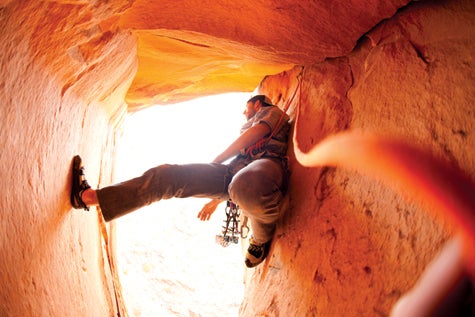
Stemming and thin face climbing may tire your feet and calves as much as your fingers and forearms, leading to imprecise footwork. Try standing on a good foothold with your heel—instead of your toe—to rest your lower leg. Alternate feet if possible.
A knobby wall provides plenty of opportunities to rest your fingers. Curl your thumb or crook your pinkie around a knob to give your fingers a chance to recover. When you reach an extra-large, flat edge, rest your forearm on the shelf instead of hanging on your hands.
If you have crack climbing skills, you can often find great rests on a face climb by hand- or finger-jamming in horizontal cracks or vertical pods. Pods or flares in a crack provide great pit stops during long laybacks—cam one foot into the pod, so you can stand up straight, get your weight over your foot, and stop pulling as much with the arms.
Overhanging Rock
Stemming is even more essential for resting on overhanging rigs, where your arms and core do most of the work. Even the shallowest corner or groove may present an opportunity for a quick stem and shake. When two planes of rock are too close together for effective stemming, you may still be able to milk them for a rest with a drop-knee: Turn your body sideways and drop your inner knee toward the ground, smearing with both feet in opposition, as if you’re chimneying. With a good enough drop-knee, you may be able to lower one or both hands for a rest.
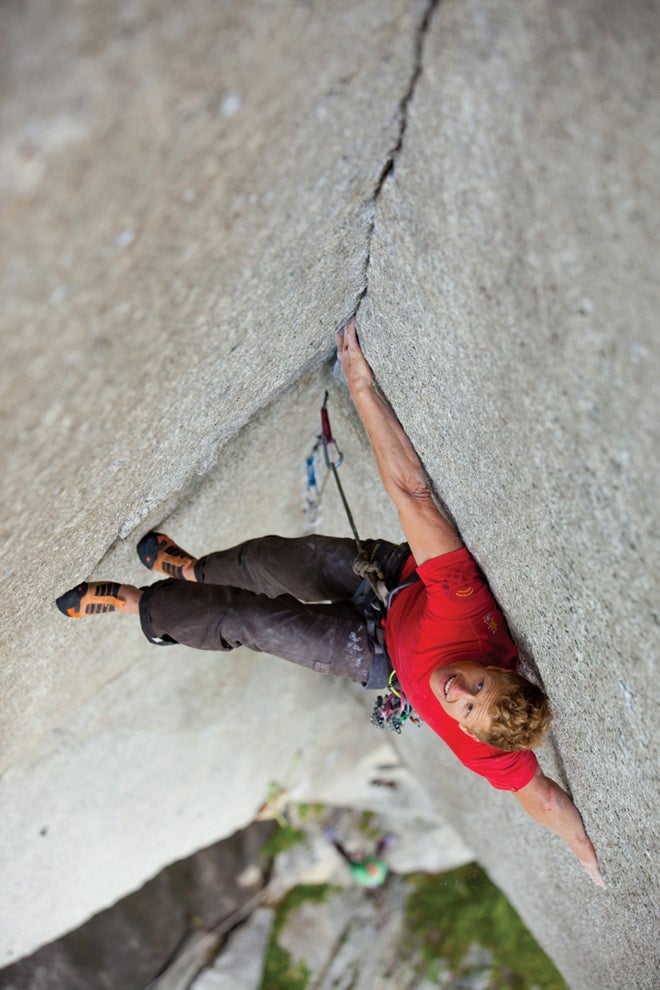
While stemming or dropping a knee, your upper body can help ease the strain on bulging forearms. Look for opportunities to “scum” a hip, shoulder, or even your head against a dihedral wall or a roof to hold yourself in balance.
The ultimate scum is the knee bar, in which you wedge your lower leg between two surfaces, with the foot and knee in opposition. Knee bars are commonly found under small overlaps or inside corners, with the leg turned sideways to press the knee against the corner wall. Strong abs will be required to use a knee bar for very long on an overhanging route.
The heel-hook is the most common rest on this terrain, and toe-hooks may also offer a good rest—an extreme version is the bat hang, in which the toe is hooked over a lip or inside a big pocket, and you hang completely upside-down to shake out. Knee-bars, heel-hooks, and other core-intensive rests often reach the point where loss of strength in your abs and legs outweighs the gains in your forearms in just a few moments. Often it’s best to shake out, chalk up, and then move on.
Get the Best Rest
Hard onsights and redpoints often come down to managing your rests well. As you suss out a climb from the ground, try to identify good rests along the way. If the rock is vertical or overhanging, you’ll want to climb without pauses between the rest positions.
When you get to a rest, hang straight-armed from the hold. Use an open-fingered grip (not a crimp), and see how little strength you can use to hang on. (Think skin friction versus grip strength.) Vary your hand position: “Piano” your fingers along a small edge to give each finger a breather; alternate fingers in a pocket; and switch to different holds, if possible, to vary the grips.
Hopefully the rest will be good enough that you can shake out each hand alternately. If necessary, adjust your feet and body position to keep your weight over your feet as you switch hands. Gently shake the hand and your loose limb, and wiggle the fingers. The goal is to get the blood moving and thus remove lactic acid from your pumped muscles. (A quick shake between holds when you’re climbing is also effective and should become habit.) Trainer and author Eric Hörst helped popularize the technique he calls “g-tox in” which the climber alternates shaking out with the hand overhead and dangling at his side. Shake out in each position for five to 10 seconds before switching. A study by British researcher Luke Roberts in 2005 showed that this method is significantly more effective at speeding recovery than the simple dangle-and-shake, probably because gravity helps circulate blood out of pumped forearms in the overhead position.
Effective recovery is as much about relaxing the mind as resting the forearms. While resting, don’t focus on anything specific. Gaze into the middle distance, take slow, deep breaths, and let your thoughts grow calmer with your exhalations. If the stance is excellent (with most of your weight on your feet or in a comfortable knee-bar or heel-hook), stay in the rest position until your breathing and heart rate slow to near normal. Take a moment to visualize the next sequence or organize your gear, and then purposefully resume climbing.
https://www.climbing.com/skills/you-suck-how-to-deal-with-regression/
The post Expert Advice for Advanced Resting Tactics appeared first on Climbing.
]]>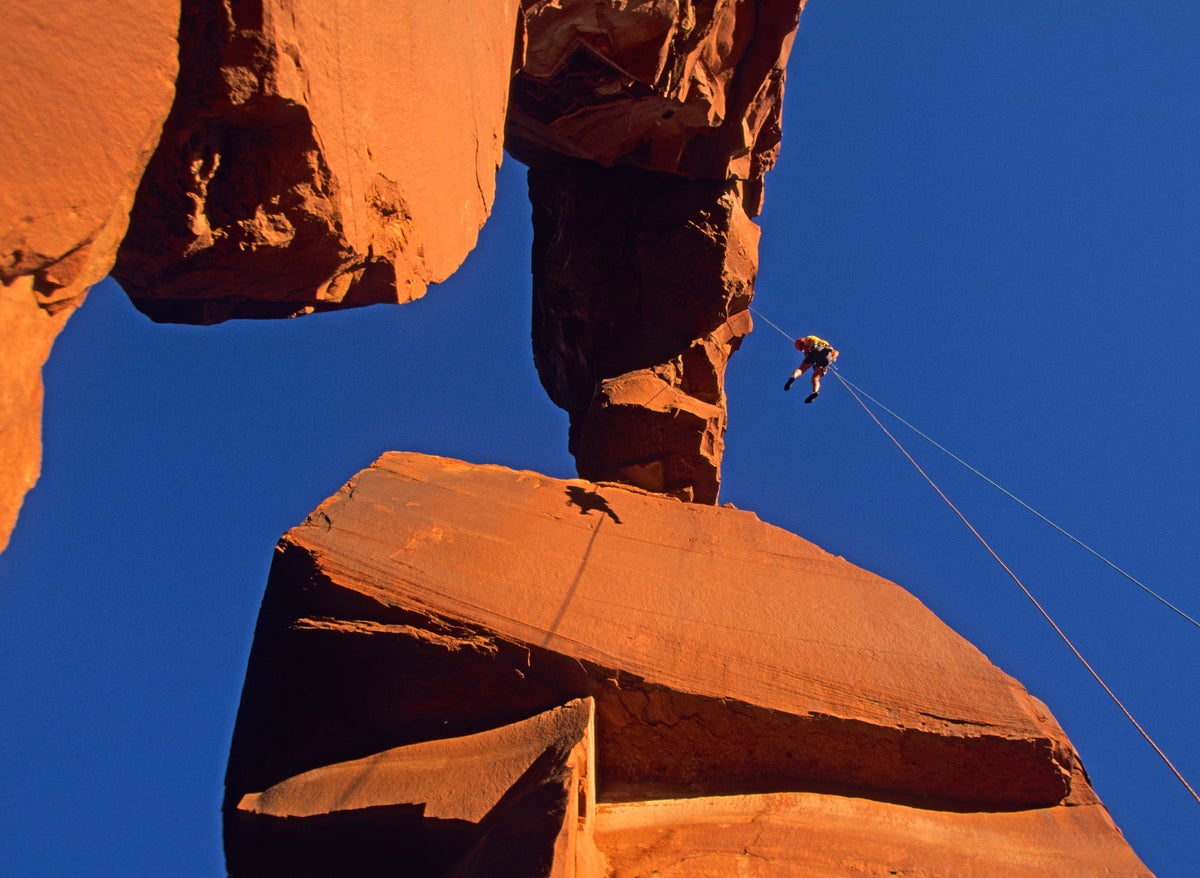
These famous climbing accidents are equal parts gripping and inspiring. If any reader should someday find themself in such a desperate situation, we hope they too will remember how others endured, living to climb another day.
The post Six Near-death Climbing Accidents Analyzed and Explained appeared first on Climbing.
]]>
Most climbing accidents happen suddenly, progress quickly, and they’re soon over. A stone falls, a piece pulls, a leg is broken. A rescue begins. Very few climbs result in true survival situations, in which the misery and uncertainty are prolonged for days or even weeks. Because of their rarity and inherent drama, many such incidents become legendary tales. Others remain private experiences, known only to family and friends.
But we also hope to inspire, for survival stories reveal the hidden capacity within many of us. Recounting their accidents, several of the climbers featured here said they drew strength by recalling Doug Scott’s epic crawl down the Ogre. And if any reader should someday find themself in such a desperate situation, we hope they too will remember how others endured, living to climb another day.
Crawling off the Ogre
- Mo Anthoine, Chris Bonington, Clive Rowland, Doug Scott
- Baintha Brakk, Pakistan; 1977
- Scenario: Two bone-breaking falls above 21,000’
- Injuries: Broken legs, ribs
- Elapsed time: 16 days
On July 13, 1977, British mountaineers Chris Bonington and Doug Scott summited Baintha Brakk (aka The Ogre), a 23,901-foot rock and ice tower in Pakistan’s Karakoram. The two men and their four teammates had spent more than a month attempting various routes up the complex peak. But any joy they felt after finally reaching the top was erased when Scott slipped on ice during the first rappel and pendulumed violently into a rock wall, breaking both legs above the ankles.
Bonington and Scott were 9,000 feet above base camp, and the sun had set. Though they had fixed ropes up the first part of the climb, descending the upper mountain would require a long traverse over the Ogre’s west summit. Just below the accident site, Bonington and Scott improvised a bivouac at over 23,000 feet without food, a stove, or even down parkas. The next morning, they continued rappelling and then were joined by Mo Anthoine and Clive Rowland, who had spent the night in a snow cave below the west summit. The three men helped Scott crawl back to the cave, where a storm pinned them for two nights.
On the third morning after the accident, despite the continuing storm, the team forced its way to the west summit, with Scott manhandling his way up ropes with jumars. It took him six hours to climb several hundred feet. After a night in another snow cave on the far side of the west peak, they continued downward, still in the storm, with Scott belayed between two partners as he crawled along the ridge. Later that day, Bonington rappelled off the end of two ropes of unequal length, plunged about 20 feet, and broke two ribs.
That night, they reached their tents, but the storm intensified once again, and they feared they’d never find the fixed ropes in the whiteout. They were forced to spend a second night at this high saddle—the sixth night since the accident—still above 21,000 feet. Their sleeping bags were soaked, and they hadn’t eaten solid food for days.
Finally, the weather broke. Bonington couldn’t use one hand and could not speak; he feared he was developing pneumonia. But after one more night in their tents, the team started down the fixed ropes. Rappelling was easier than crawling for Scott, and they all made it down to the glacier that day.
Next blow: Anthoine arrived at base camp only to find it had been abandoned. Fearing their partners were dead, the team’s other climbers had sent the porters ahead and left for town hours before Anthoine arrived. One left a note: “In the unlikely event of your reading this, I have gone down for help.” Now Scott had to keep crawling, across nearly five miles of glacier and moraine. Ice and dirt wore through four layers of clothing and rubbed his knees raw.
And it wasn’t over. Anthoine had run ahead to catch the other climbers, but Scott and Bonington had to wait five days at base camp until one of the climbers returned with a dozen porters, who ferried Scott for three days down the glacier on a homemade litter. A small helicopter finally arrived to pick up Scott, but it crash-landed in Skardu. Scott and the other passengers were unharmed, but Bonington had to wait another week before he could escape the mountains.
Bonington wrote: “It was certainly the most harrowing experience that either Doug or I have ever had, and yet throughout the long drawn-out retreat, there was never a sense of despair. This was largely due to the quality of support we had from Mo and Clive, and the fact that none of us lost his will to survive or showed the doubts that we might secretly have had.”
The Ogre was not climbed again for 24 years.
- LESSONS: Scott later explained how he managed to keep going for so many days, despite so many obstacles: “Take it one feature at a time. A nub of rock, a pinnacle. Get there and then think about the next bit. Because to think about the whole thing was a bit mind-boggling.” Focus on the immediate tasks at hand, he tells us, instead of wasting time and energy worrying about your plight.
- READ IT: None of the climbers wrote a book about this expedition, but there are good accounts in the American Alpine Journal (1978), High Drama by Hamish MacInnes, and Himalayan Climber by Doug Scott.

Hanging On
- Coral Bowman
- Eldorado Canyon, Colorado; 1978
- Scenario: Free-fall after failed rappel
- Injuries: Severe rope burns
- Elapsed time: Minutes
Coral Bowman, one of Colorado’s strongest female climbers during the late 1970s, hoped to complete the first all-woman ascent of The Naked Edge, the five-pitch 5.11 in Eldorado Canyon. On September 12, 1978, Bowman and Sue Giller quickly climbed several pitches to the first belay of the Edge, trailing a 9mm rope for hauling a pack with sweaters and water. Trading leads, they successfully free-climbed the first two pitches of the Edge, and Giller was leading the easier third pitch when the haul rope jammed below Bowman’s belay ledge. She yelled to Giller to climb back down to the ledge, so Bowman could rappel their single lead rope to the free the stuck haul line, and then reclimb the second pitch on toprope.
Feeling impatient with the delay, Bowman rushed the anchor set-up and failed to reverse the gates of the two carabiners that clipped the rope to the anchor sling. As she leaned over the wall atop pitch two, the sling pushed open the carabiners and the rappel rope popped out. Bowman free-fell toward the ground, about 300 feet below.
Time seemed to stop. Bowman remembers looking over her shoulder at the ground and imagining concerned friends watching. Then, after plummeting about 20 feet, accelerating fast, she reached out and grabbed the 9mm haul rope with both hands. Though her hands burned horribly from the friction, Bowman managed to slow and then stop her fall. She wrapped the free end of the haul rope around her leg to relieve the strain, and with her hands beginning to stiffen into useless claws, she inserted the skinny haul rope into her carabiner brake and slid down to the anchor atop the first pitch. Giller joined her and began lowering Bowman to the ground for a trip to the hospital, badly shaken but grateful to be alive.
- LESSONS: Bowman was distracted that day by relationship issues, and felt rushed because of weather concerns. It’s a reminder that accidents usually happen when climbers lose their focus. And, of course, it’s mandatory to double-check your anchors and rappel set-up—and that of your partners.
- READ IT: Bowman tells her story in Rock & Ice 86 (July 1998).
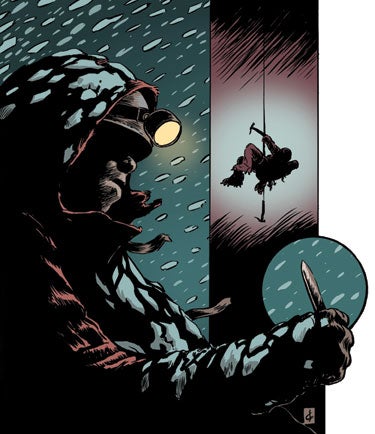
Touching the Void
- Joe Simpson
- Siula Grande, Peru; 1985
- Scenario: Broken leg; fall into deep crevasse
- Injury: Severely injured right tibia, knee, ankle, and heel
- Elapsed time: 5 days
The elements of this story are so famous they scarcely need retelling, yet they remain astonishing: Joe Simpson breaks his leg in a fall while descending 20,814-foot Siula Grande after a new route on the west face; his partner, Simon Yates, lowers him about 2,500 feet before the knot joining their two ropes jams in Yates’ belay device, leaving Simpson stranded in mid-air, in the dark, above a crevasse; Yates, unanchored and about to be pulled from the face, makes the agonizing decision to cut the rope, sending Simpson plunging 150 feet into the crevasse. When Yates reaches the glacier the next morning, he calls out for his partner but concludes he must be dead. Simpson, stranded on a snow shelf inside the crevasse, assumes he will die. The crevasse yawns below his tiny ledge; he retrieves the rope and sees it has been cut, and thus knows his partner is gone.
After trying to climb out and then spending a long night on the ledge, Simpson decides his only option is to rappel deeper into the crevasse. “I pretty much thought it was a form of suicide,” he says today. “I didn’t have the courage simply to jump off. I didn’t put a knot in the end of the rope—it would be quick that way.”
Miraculously, the rappel led to another ledge about 80 feet lower, from which Simpson was able to crawl up to the surface. He emerged on the sunny glacier hours later. Now there was hope, but still he had to crawl about five miles to reach base camp. It took him three and a half days to get there, without food and no water until the last day. Yates and an acquaintance had by then given up hope and had packed to leave. Simpson neared camp late at night and called out for his friend. Says Simpson: “Seeing the white beams of Simon and Richard’s head torches suddenly flicking on in the night was unforgettable.”
- LESSONS: Looking back, Simpson concludes that decisions they made before the climb contributed to his fate. Though they were trying to go light, they should have packed extra food and stove fuel, he says. “The lack of gas and food meant that when we reached the col after breaking my leg, we couldn’t hunker down in a snow cave in warm sleeping bags, drinking hot tea,” he explains. “For the sake of a few gas canisters, we lost control of events and felt forced to descend in the dark. The rest is history.” The other lesson from this episode is perhaps obvious but deserves to be stated: Humans can endure far more than what anyone might think possible, as long as they don’t give up.
- READ IT/SEE IT: Touching the Void, Joe Simpson’s book about the ordeal, is one of the most harrowing climbing stories ever written. Kevin MacDonald’s 2003 movie of the same name is perhaps the best climbing film ever produced.
The Downclimb
- Jean-Christophe Lafaille
- Annapurna, Nepal; 1992
- Scenario: Alone at 23,500’ with no rope or hardware
- Injuries: Badly broken arm
- Elapsed time: 5 days
Pierre Beghin and Jean-Christophe Lafaille hoped to climb a new route on the nearly two-mile-high south face of Annapurna. Lafaille, only 27, was on his first Himalayan expedition. They fixed about 500 feet of rope; otherwise, they were climbing alpine style. After four days, they were forced into a standing bivouac on 70-degree ice, in a storm, at 24,000 feet. They made it only 600 feet further before the storm prompted them to turn back.
Conserving gear for the long descent, Beghin built one anchor from a single cam. Partway through this rappel, the cam popped and Beghin fatally plunged into the void, taking the ropes and all their hardware. Lafaille was alone at about 23,500 feet—more than 6,000 feet above advanced base camp.
Too stunned to move at first, Lafaille eventually began to solo down 75- to 80-degree mixed terrain. He didn’t make it to the bivy site 600 feet lower until 9 p.m. He stayed there all the next day while the storm continued. After another night, having recovered 20 meters of 6mm cord they’d left at the bivy site, he started descending again. With only a single sling and two carabiners for gear, he used lengths of tent poles for rappel anchors. Then Lafaille lost a crampon. Two hours later, amazingly, he discovered the missing crampon in soft snow.
Finally he reached their ropes and began rappelling toward the cache of supplies they had left at 21,650 feet. Then a falling rock smashed into his right arm, breaking both bones—and Lafaille was right-handed. In the morning, it took him half an hour just to light his stove. He rested all day, and then began rappelling again, using his good hand and his teeth to rig the rappels. When it became too difficult to pull the ropes, he abandoned them and continued down climbing. Finally he staggered into base camp.
- LESSONS: “The sum of everything I’d done over the last 10 years got me out of that situation,” Lafaille said. His extensive soloing in the Alps prepared him, as did down-climbing skills— something that many experienced alpinists and traditional rock climbers practice often. Ingenuity also was key: When an obvious solution (pitons and cams for rap anchors) is not available, consider every alternative (such as tent poles). Finally, and obviously, single-anchor rappels should be an absolute last resort.
- READ IT: Prisonnier de l’Annapurna by Jean-Christophe Lafaille; Climbing 141 (December 1993) and Climbing 197 (September 2000).
Crashed
- Takeyasu Minamiura
- Trango Tower, Pakistan; 1990
- Scenario: Paragliding disaster at 20,000’
- Injuries: None
- Elapsed time: 10 days
Takeyasu Minamiura’s climb would have been a testament to fortitude and endurance even if nothing had gone wrong. The 33-year-old climber spent 40 days soloing a new route on the northeast buttress of 20,469-foot Trango Tower (commonly known as Nameless Tower)—a 30-pitch line with leads up to A4—and hauled hundreds of pounds of food, water, and equipment the entire way. On September 9, he stood just below the summit and prepared for his most radical move yet: He attached a small parachute to the haul bags containing all of his hardware, ropes, food, and bivouac equipment and launched them toward the Dunge Glacier, 6,000 feet below. Then he clipped into a paraglider and prepared for his own aerial descent.
The launch did not go well. Almost instantly Minamiura was upside-down and falling. The canopy collapsed, and the Japanese climber slid toward oblivion. But the chute that had failed him saved his life; it snagged on a rock, halting Minamiura’s slide. He had only a down jacket for warmth, but he still had his radio, and so, hanging in his harness from the paraglider rigging, he called to friends who had just finished their own epic climb on nearby Great Trango. The four Japanese at base camp began planning a rescue.
Minamiura spent the night with his feet dangling, but in the morning he managed to escape the rig and traverse to a 16-inch-wide ledge. He would spend the next six days there. Two of his friends hiked toward a Pakistani army helicopter base, and they talked the pilots into attempting a rescue. But as they neared Minamiura at 20,000 feet, the Pakistanis’ Lama helicopter grew unstable, and the pilot abandoned the attempt.
Meanwhile, the other two Japanese climbers assembled their gear and asked to be flown to the Trango Glacier, on the other side of the tower. They started up the British Route on the south face, which hadn’t been repeated since the spire’s first ascent in 1977. The climbers jumared frayed, 14-year-old fixed ropes and led as fast as they could. Minamiura wrapped himself in his back-up chute (which was too low-performance for the risky flight from the tower) and rubbed his feet all night to keep them warm; he slept during the day. Twice, pilots tried unsuccessfully to drop food and water for him. But after the second drop, on September 15, the pilot radioed that a block of cheese had wedged into a flake 15 feet above him. Minamiura decided to risk the climb to the cheese, and in the process he discovered a larger ledge, where more food could be sent to him. Finally, on September 16, after racing up the British Route in just three days, the Japanese climbers reached the summit of Trango Tower and quickly rappelled to Minamiura’s ledge. Two days later, Minamiura was back on the glacier, 49 days after leaving.
- LESSONS: Though some climbers understandably prefer to maximize the adventure of wilderness expeditions by climbing without a radio or satellite phone, Minamiura surely would have perished if he could not have radioed for help.
- READ IT: Climbing 197 (September 2000)

The Belay
- Robert Bates, George Bell, Robert Craig, Art Gilkey, Charles Houston, Dee Molenaar, Pete Schoening, Tony Streather
- K2, Pakistan; 1953
- Scenario: Retreat from 25,000’ with fatally ill partner
- Injuries: Blood clots, frostbite, concussion
- Elapsed time: 14 days
The world’s second-highest peak might have been climbed by a small team of Americans in 1953, but the attempt ended at high camp, when Art Gilkey was stricken with blood clots, and an extraordinarily selfless rescue effort began. The American expedition had arrived at base camp on June 20, and by August 1 they had established eight camps on the Abruzzi Spur, with the highest camp on the Shoulder, about 2,600 feet below the top (site of today’s Camp IV). Here, they would begin their summit push. On August 2, the whole team was in place. But a storm developed, and the climbers were stuck in their tents for five nights. The weather improved on August 7, but then Gilkey collapsed outside his tent. Charles Houston, a doctor and the expedition leader, diagnosed him with blood clots—practically a death sentence at this altitude. Worse, the storm had returned.
On August 10, with everyone’s condition deteriorating fast, they decided to head down. Though few believed Gilkey would survive, they did not abandon him. Instead, they fashioned a stretcher and began lowering and dragging the sick man toward Camp VII. Their descent route crossed a steep ice slope. Pete Schoening lowered Gilkey with the rope wrapped around his body and an ice axe jammed behind a rock. Dee Molenaar led the way in front. Above them, another climber slipped and pulled off his partner, and then tangled with the remaining rope teams until five climbers were falling. Somehow, Schoening held on and brought them all to a stop, a feat since immortalized as “The Belay.”
The badly shaken climbers made it to the lower camp, only to discover that Gilkey, who had been anchored to the ice slope, had vanished, possibly in a self-sacrificial act to save his teammates. The survivors were exhausted. Houston had a head injury, and some were frostbitten. It took another five days to reach base camp.
- LESSONS: Few expeditions in history have demonstrated such selflessness and teamwork, and this was partly a result of Houston and Bates’ careful selection of a small (by 1950s standards) and harmonious team. “We entered the mountain as strangers, but we left it as brothers,” Houston said. Obviously, it pays to choose your partners carefully. Schoening’s ice axe belay also proved instructive. Though not as strong or reliable as a well-anchored belay from a harness, ice axe belays are quick to establish, and, as K2 demonstrated, they can be lifesavers.
- READ IT/SEE IT: K2: Savage Mountain, by Charles Houston and Robert Bates, is a must-read classic. Pete Schoening’s wood-shafted ice axe is on display at the Bradford Washburn American Mountaineering Museum in Golden, Colorado.
“A direct hit might have killed me”: 5 Climbers and Their Worst Head Injuries
https://www.climbing.com/people/accident-with-loose-rock-nearly-kills-climber/
Soloist Is Stranded Midway Up Longs Peak. His Rescuer Piggybacks Him Up 5.4 To Safety
The post Six Near-death Climbing Accidents Analyzed and Explained appeared first on Climbing.
]]>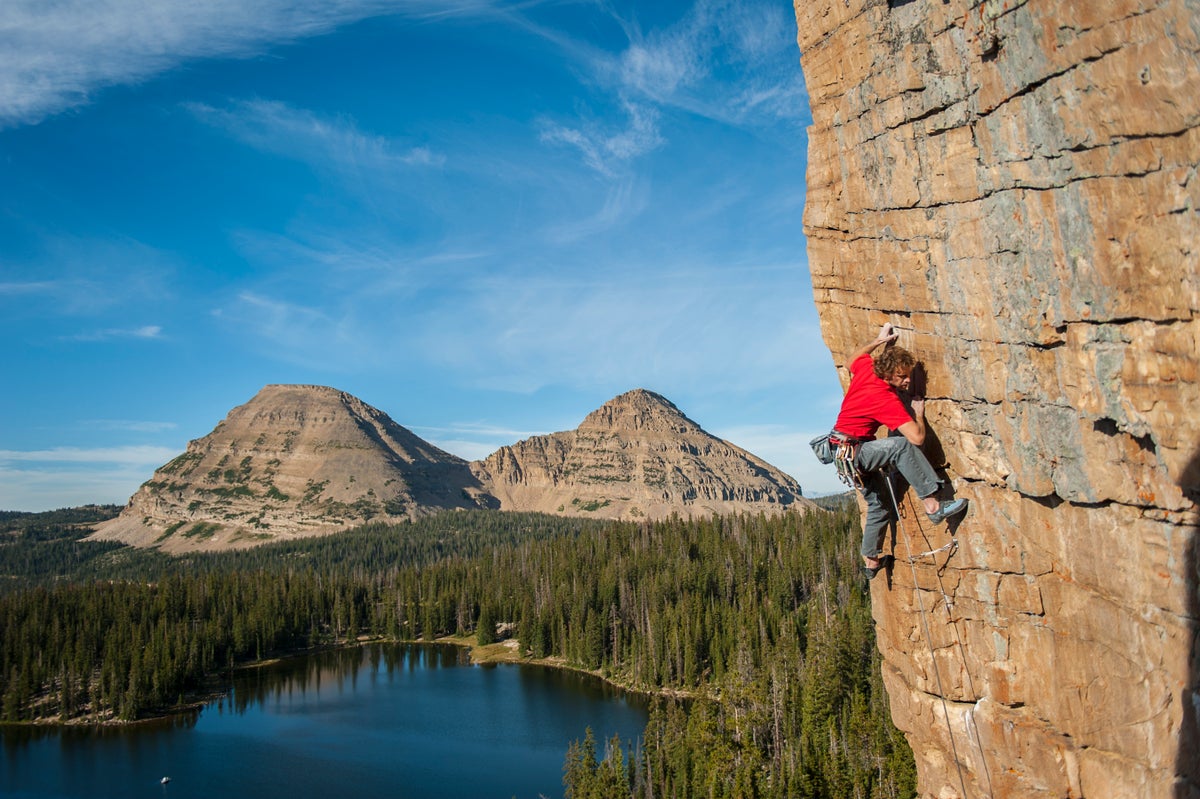
Get this high elevation rock while you can!
The post Our Favorite High-Elevation Crags to Beat Summer’s Heat appeared first on Climbing.
]]>
This story originally appeared in Climbing September 2015 .
It’s easy to be complacent about midsummer climbing—those sultry days, the allure of the swimming hole, the crack of a beer… There always seems to be more time. But you know what? All too soon the high peaks will be buried in snow and steel gates will clang shut across mountain roads. True, you could still reach many rocks with a bit of hiking (or snowshoeing). But if anything, winter apathy is even more powerful than summer languor. So don’t wait! In late summer and early fall, the crags are dry, nasty bugs have vanished, and foliage is bursting into brilliant color—it’s prime time for high-country cragging.
Uinta Mountains, Utah
The place for cool quartzite cragging
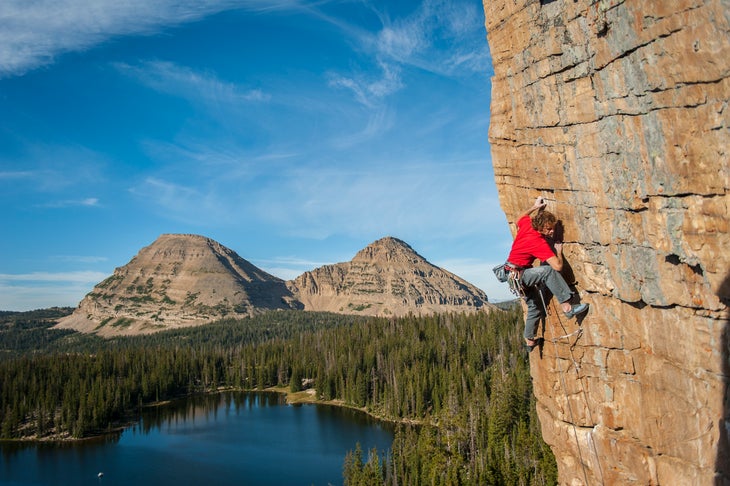
The paved Mirror Lake Scenic Byway (State Route 150) twists through the Uinta Mountains, a cool alpine refuge from the blistering heat of Salt Lake City about 1.5 hours away. With about two dozen crags, nearly all above 10,000 feet, dotted among the lakes and bare mountaintops, the Uintas are flat-out gorgeous. The tiered quartzite crags have a mix of trad and sport routes. Most first-timers head to the bolted crags above Ruth Lake, with lines of all grades quite close to the road. If you like crimpy 5.10 and 5.11 sport routes, this is your place.
For a mix of grades on vertical to super-steep routes, head to the Stone Garden a few miles north (downhill) from Ruth Lake. Sessions (5.12a) and Obsessions (5.12b) both have the proverbial “biggest holds you’ll ever fall off.” The nearby Mosquito Wall has about 18 bolted routes, most of which are 5.9 or easier. For getting off the beaten path, guidebook author Nathan Smith recommends Cliff Lake (“three steep 5.10s and a handful of easier lines”), Notch Lake (“a 2.3-mile hike in, but it goes by quickly and you will rarely find anyone else there”), and the Wall of Tiers (“close to Ruth Lake in overall quantity of great climbs, but many of these are mixed or trad, so they don’t see the traffic”). In recent years, several climbers have been developing walls on 12,479-foot Hayden Peak, including three- to five-pitch routes (mostly trad with bolts in key places) on the 400-foot, west-facing Iron Hayden Wall.
Uinta Mountains Beta
Prime Season: July to September
Average Closing Day: November 7
Tip: Save the Ruth Lake crags for a heat wave—they’re shady almost all day. Uinta mosquitoes can be fearsome—bring bug dope and long sleeves.
Road Conditions: UDOT Traffic
Guidebook: Uinta Rock, by Nathan Smith and Paul Tusting, is out of print but may be found in stores. Otherwise, Mountain Project has the beta, including the previously unpublished lines on Mosquito Wall and Hayden Peak.
Evans Notch, New Hampshire/Maine
Go wild in the White Mountains

Route 113 is a seasonal highway along the Maine–New Hampshire frontier, crossing a 1,410-foot high point at Evans Notch. Looming over this pass is the Laughing Lion, a 350-foot cliff of twisted schist with three- to four-pitch, mostly bolted routes that ascend gently overhanging, techy faces. “It’s high elevation for a New England cliff—the base is around 2,000 feet, about the same as Cannon Cliff but a lot more sheltered,” says local guide Bayard Russell. “It has some incredible exposure, really varied climbing, and the whole thing is capped by a huge roof.” Recommended routes include The Hustler (5.11c), Mane Line (5.11d, 4 pitches, mixed gear and bolts), and Acid Wall (5.12d, 3 pitches, sport).
At the north end of the Evans Notch road, about three miles from Gilead, Maine, the Wild River Road branches to the southwest, leading to the trailhead for a small but superb sport crag known as Wild River. After 45 minutes of hiking you’ll reach the land of endurance pumps, with 140-foot routes following overhanging corners and arêtes. “Wild River is a great little crag with incredible swirly rock,” Russell says. “The crag is cool (east-facing), and the rock has a great texture that can punch through the summer slime.” Russell recommends the nearly side-by-side triumvirate of Wild Life (5.12a/b), Wild Thing (5.13a), and Big Red (5.11d).
Evans Notch Beta
Prime Season: August to October
Average Closing Day: December 1
Tip: Nesting peregrine falcons may close Laughing Lion until late July. Bring a swimsuit (or whatever) for the pools and water slides below the Wild River cliff.
Road Conditions: White Mountains Forest Road Status
Guidebook: North Conway Rock Climbs, by Jerry Handren
Black Mountain, California
Go high into the San Jacinto Mountains for legendary SoCal boulders
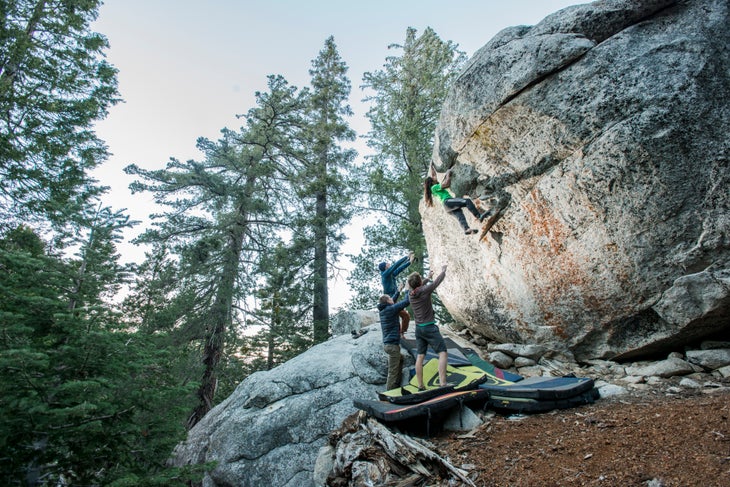
The Stonemasters drove up to the piney woods of Black Mountain three decades ago to escape SoCal’s summer heat, and boulderers still flock to these big, bold granite blocks. “Imagine the boulders of Yosemite meet the texture of the Buttermilks,” say the authors of Black Mountain’s brand-new guidebook. “The patina isn’t as pronounced as it is at the Buttermilks, but the best lines are every bit as stunning as those found in the Valley.” Authors Ian McIntosh and Alan Moore recommend first-timers head straight to the Boulder Basin Campground to start sampling the 1,700 known problems on the mountain, with climbs of all difficulties. Problems like Big Greeny (V1/2) or the calendar-worthy Once Upon a Time (V1 X) will vividly demonstrate one of Black Mountain’s key characteristics: These rocks are high. “Boulders at Black Mountain do not go easily,” McIntosh says. “The climbing here is often highly technical and powerful at the same time. A positive state of mind is required to supplant the absence of positive holds high off the deck. This only makes the Black Mountain experience more gratifying.”
Also gratifying are the superb sunset views off the west side of the mountain, tempting climbers to linger for one more problem before returning to the sweltering valley. “I can’t emphasize enough the beauty of the sunset,” Moore says. “It completely transforms the mountain. I often hike out in the dark because I don’t want to miss the final moments of golden light.”
Black Mountain Beta
Prime Season: October to December; March to May
Average Closing Day: December 15 (sometimes open year-round
Tip: A high-clearance vehicle is recommended but usually not essential
Road Conditions: Inquire at the Idyllwild ranger district about access to Boulder Basin Campground (909-382-2921).
Guidebook: Black Mountain Bouldering, by Ian McIntosh and Alan Moore
Needles Highway, South Dakota
Bag a spindly granite spire

Early fall is the time to hit the Needles, when the roar of the Harleys has diminished (the annual Sturgis motorcycle festival is just 65 miles away) and the “how do you get the ropes up there” crowds have gone back wherever they came from. Even more important, crisp autumn temps and low humidity guarantee maximum friction on the Needles’ slick crystals.
Highway 87 threads through the amazing granite spires and buttresses of Custer State Park, with a few climbs starting so close to the road that you can step off a guardrail for the first move. The guardrail that threatened John Gill’s life during the unrehearsed solo first ascent of The Thimble in 1961 is gone, but danger remains—this highball was probably the first 5.12 in the country. Plenty of easier but no less exciting climbs line the road, like the famous Needle’s Eye, which you can summit by a 5.8+ route or chimney the eye via Threading the Needle (5.8) for the ultimate photogenic pose-down—keep in mind that both climbs require confident leaders. Down in the Ten Pins area, don’t miss Tricouni Nail (aka Cerberus, 5.8), a ridiculous tent pole of a tower where the descent is a simul-rappel off either side, with no anchor on top. (It’s safer than it sounds.) If all the runouts are wearing you down, head over to Reunion Rock for the well-bolted Loss of Sensation, a 5.10a with great views over the Cathedral Spires.
Needles Highway Beta
Prime Season: June to early October
Average Closing Day: November 1
Tip: Bring plenty of slings and a small trad rack to supplement fixed pro on the bold face climbs. “Slings are endlessly useful for tying off chickenheads or extending gear placed off to the sides,” says guidebook author Zach Orenczak. “You’ll be running it out here and there, but the cliffs are littered with jugs. It’s all in the mind.”
Road Conditions: Safe Travel USA: South Dakota
Guidebook: The Needles (2014 edition), by Zach Orenczak and Rachael Lynn
Washington Pass, Washington
Take the short hike to North Cascades alpine cragging
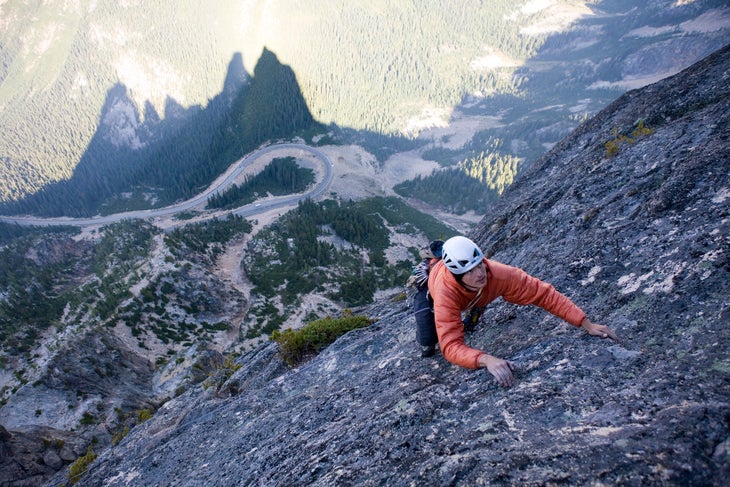
Washington Pass is an alpine climbing area with all the usual hazards—storms, loose rock, snowfields. It’s best known for summit climbs like the Beckey Route and Liberty Crack on Liberty Bell, the closest tower to the road. But the super-short approach from State Route 20—short by alpine standards anyway—along with a selection of great half-day climbs and some primo bouldering, make this an awesome destination for rock climbers as well. “The best bouldering and the best climbing wall at Washington Pass—Liberty Bell—has only a 40-minute approach!” says Cascades local Blake Herrington. “And you can rap with one rope after climbing the first five or six pitches of the lines on the east face.”
Avoid the east-face crowds on Liberty Crack (usually aided but goes free at 5.13) by trying the free version of Thin Red Line, a classic wall route freed by Mikey Schaefer. The first four pitches go at 5.11, or you can try the two 5.12 pitches above—you can bail anywhere with a single 70-meter rope. Or try the mostly bolted Freedom or Death (5.12a), a four-pitch start to Liberty Crack.
Other nearby towers offer other good mid-length climbs, including a 5.9+ crack climb on the east face of Lexington Tower that sneaks through some impressive roofs, and the 5.9 to 5.11 routes on South and North Early Winters Spires. If you find you’re not getting enough action, this is a great area for multi-route link-ups.
Washington Pass Beta
Prime Season: Late June-September
Average Closing Day: October 20
Tip: Two ropes are needed for most rappels
Road Conditions: North Cascades Highway Status
Guidebook: Washington Pass Climbing, by Ian Nicholson; Selected Climbs in the Cascades, by Jim Nelson and Peter Potterfield; Cascades Rock, by Blake Herrington.
Sonora Pass, California
Enter the northern Sierra’s granite playground
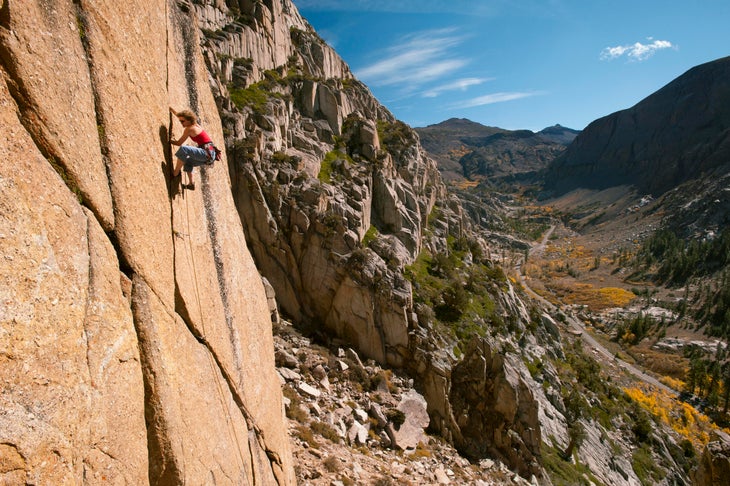
While out-of-staters flock to the Sierra’s big-name summer crags—Tuolumne Meadows, Donner Pass, the Needles—northern California climbers increasingly opt to drive up Sonora Pass, the second-highest pass in the state. Once the deep Sierra snowpack has melted back—deep in normal years, that is—Highway 108 over the 9,624-foot pass gives access to dozens of crags at Chipmunk Flat, 5N06, Burst Rock, and other areas. The new guidebook covers upwards of 1,500 routes, many of them done in the last decade.
Most of the rock is granite, but there’s nearly endless variety, including a mix of trad and sport routes. “You can have perfect Tuolumne knobs and splitter cracks up at Burst, Frankensteins, and Chipmunk Flat, and quartz-veined gneiss at the Lost World,” says photographer and local climber Jerry Dodrill. “And Columns of the Giants is a steep volcanic cave, similar to Jailhouse and the other Table Mountain areas, that is climbable even when the High Sierra thunderstorms chase you off the granite.” Most of the routes are one to four pitches, but longer lines are out there, including the super-adventurous, canoe-access, 10-pitch trad lines above Donnell Reservoir.
“There is plenty of free camping, fishing, mountain biking, and a refreshing, hassle-free vibe,” Dodrill says. “I’ve been climbing up there and putting up routes since the late 1990s, and I feel like I’ve still just scratched the surface.”
Sonora Pass Beta
Prime Season: June to October
Average Close Day: December 15
Tip: If bad weather chases you out of the high country, the popular volcanic sport climbs of the Grotto and Jailhouse Rock are only an hour or so away.
Road Conditions: California Road Information
Guidebook: Climber’s Guide to the Sonora Pass Highway (2nd Edition), by Brad Young and Steve Dawson
Table Rock, North Carolina
Get a taste of multi-pitch adventure in the Southeast
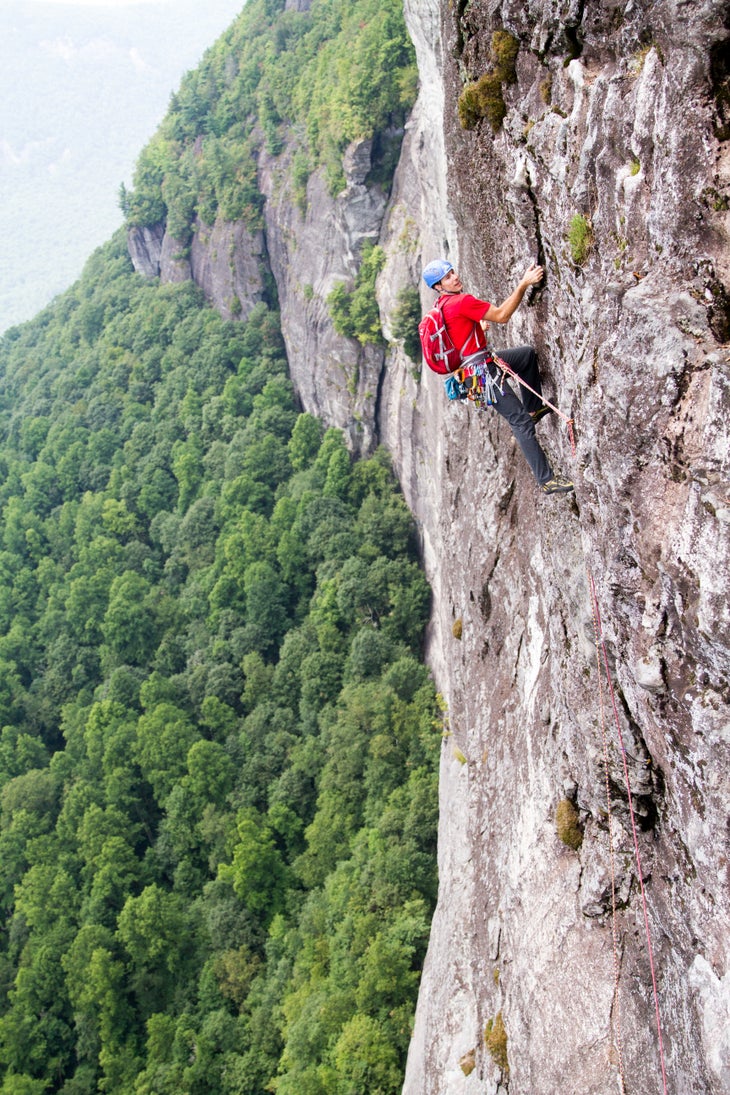
The walk to Table Rock when the steep, switchbacked access road is closed likely won’t leave your feet too blistered to stuff into rock shoes—it’s only about two miles from the winter gate to the crag. But it’s usually too cold to climb then anyway. This cliff is most popular in the warmer months, when climbers flock to the shady quartzite cliffs, up to 300 feet high, hoping to catch a cooling breeze high on the east side of Linville Gorge. With a plethora of easier climbs and classic routes up to four pitches, let’s not sugarcoat it: Table Rock can swarm with climbers. (A helmet is a must.) But there are plenty of routes to spread people around. Newcomers to multi-pitch climbing will love the North Ridge (5.5, 3 pitches) or Peek-a-Boo (5.5, 3 pitches), with its dramatic step-across move. More experienced trad leaders won’t want to miss the brilliant corners of White Lightning (5.8, 2 pitches) or the varied Second Stanza (5.8+/5.9, 4 pitches). Though Table is known as a beginner’s area, the steep lower walls have been developed with harder climbs as well, including the bulging Waste a Bit (5.10+) and Indecent Exposure (5.11c), both protected with a mix of gear and bolts, as well as the 5.11c seam of On Misty Edge.
Table Rock Beta
Prime Season: April-November
Average Close Day: January 1
Tip: Newcomers to outdoor or traditional climbing shouldn’t underestimate these climbs just because they have a low number grade, says guidebook author Harrison Shull. “The cliff is ledgy and thus the perfect place to crush an ankle if you get careless, over-bold, or both.”
Road Conditions: Call the Grandfather Ranger District at 828- 652-2144.
Guidebook: Selected Climbs in North Carolina, by Yon Lambert and Harrison Shull
Smugglers Notch, Vermont
Adventure cragging in New England ski country
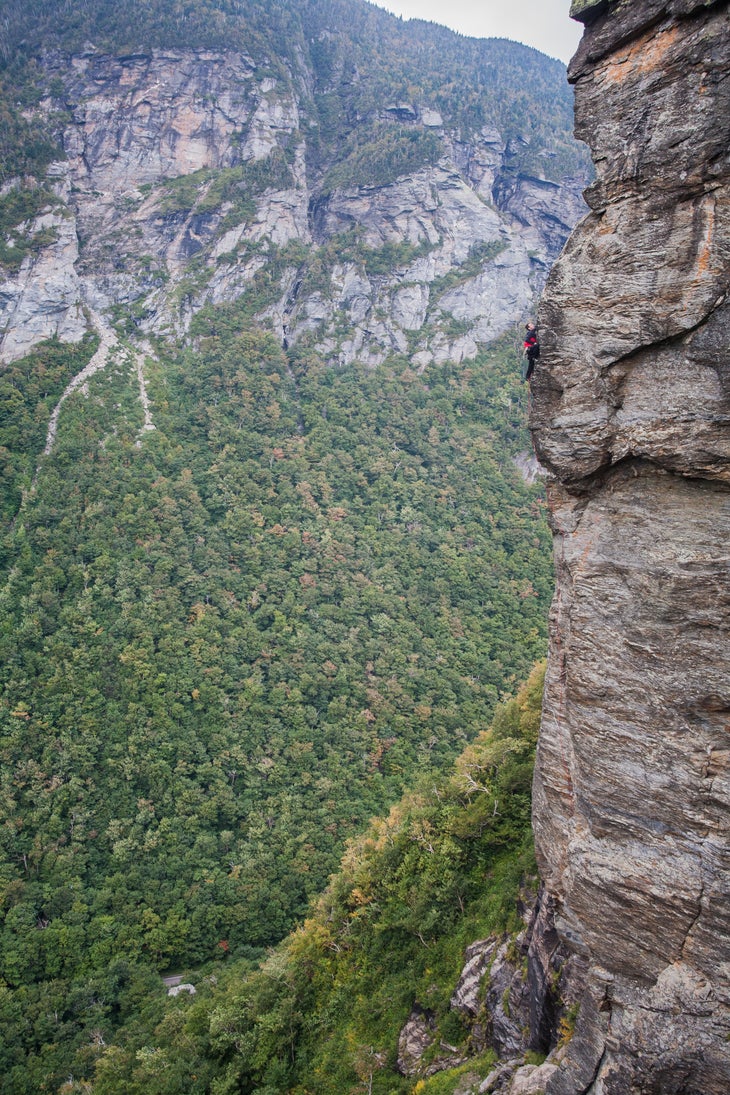
North of the Stowe ski area and bordered on one side by Vermont’s highest peak, Smugglers Notch is a treasured area for ice climbing, and it feels nearly as adventurous in the summertime. Alpine-like conditions—wet, mossy, sometimes-loose rock, threatening weather, and thrashing approaches through stinging nettles predominate. Even the route descriptions are often given in reference to nearby ice climbs. If this doesn’t scare you off, you’ll find some of New England’s best adventure climbs among the buttresses looming over Route 108.
Guidebook author Travis Peckham recommends The Diagonal (5.8+, “wild exposure and cool climbing on the second pitch”), Quartz Crack (5.9, “great climbing and an amazing position make this a Smuggs classic—be prepared to draw a crowd of amazed tourists”), and Ganesh (5.12a), an exposed four-pitch line up the right arête of the towering Elephant’s Head buttress. You can also try the stunning, bolt-protected left arête of Elephant’s Head via the route Airavata—the first three pitches go at 5.11, with a final 5.12b lead to the summit if you’re up to it. The area behind the visitor center and parking lot at the top of Smugglers Notch holds a maze of blocks and caves with some of northern New England’s best bouldering. Classic problems include Pac Man (V3/4), the highball General Patton’s Arête (V3), Nemesis Traverse (V5), and The Green Egg (V6).
Smugglers Notch Beta
Prime Season: Late June to September
Average Close Day: October 20
Tip: Wait a while after the road opens before heading to Smuggs—or be flexible in your route choices. Some routes stay wet through at least early July.
Road Conditions: Vermont Agency of Transportation
Guidebook: Tough Schist, by Travis Peckham (updates at vermontrock.com); New England Bouldering, by Tim Kemple
Independence Pass, Colorado
Get your Rocky Mountain high at this granite playground

When climbers in western Colorado refer to “The Pass,” they’re talking about the twisting approach to 12,095-foot Independence Pass, like a road straight out of the Giro d’Italia. Dozens of crags and boulderfields line the highest paved road across the Continental Divide in the North America, especially on the Aspen side. (Climbing magazine founder Harvey Carter was active on the Pass, and the magazine operated out of Aspen and nearby Carbondale for more than three decades.) Most of the crags along Colorado Highway 82 are between 9,000 and 10,000 feet in elevation.
The Pass is all about granite in its many forms. For trad climbing, start at Grotto Walls. Twin Cracks (5.8) has a wild overhanging finish, and the classic Cryogenics can be climbed as either a one-pitch corner (5.10a) or with a bulging 5.11c second pitch. Higher up the hill is the classic Plaque Right (5.9). There’s also an assortment of testy crack and flake climbs, from 5.7 to 5.13, on the various Lincoln Creek crags.
For sport climbing, the Olympic Wall is stacked, with highlights including Standing Eight Count (5.11c) and I’ve Got Skills (5.12a). The nearby Thindependence and Outrageous Overhangs crags will ensure your fingers don’t fail to get worked. Boulderers can start at the Jaws Boulder, with its classic V3 of the same name, or Upper Boulderfield. The cliffs at the Pass mostly face south, and the high-elevation sun can make them surprisingly hot. Afternoon shade can be found at many of the Lincoln Creek crags, and thunderstorms frequently cool things off—or chase climbers to the fleshpots of Aspen.
Independence Pass Beta
Prime Season: Memorial Day to October 31
Average Closing Day: November 1
Tip: Monitor Rock on the east side (accessible from Leadville) is easily reached in spring, before the road over the pass opens.
Road Conditions: CO Trip Road Conditions
Guidebook: Independence Pass Rock Climbing II, by Tom Perkins
The post Our Favorite High-Elevation Crags to Beat Summer’s Heat appeared first on Climbing.
]]>
157 years ago, today, the Matterhorn saw its first ascent. To celebrate that fact, we present 10 fun facts about Europe’s most famous summit.
The post 10 Things You May Not Know About the Matterhorn appeared first on Climbing.
]]>
1. At 4,478 meters (14,692 feet), the Matterhorn is only Western Europe’s 12th-highest peak, but it is taller than Mt. Whitney, the highest summit in the Lower 48 of the U.S., by about 187 feet.
2. The Matterhorn straddles two countries, Switzerland and Italy, and has three common names. The German name Matterhorn derives from the words for “meadow” and “peak.” The Italian name, Cervino, and French, Cervin, likely originated with the Latin word for forest, silva, though some believe it comes from the Italian and French words for “deer.”
3. The first ascent on July 14, 1865, from the Swiss side of the mountain, ended a race that lasted nearly a decade and came down to the wire, with rivals on the Italian side poised only 1,250 feet below the top when Edward Whymper and Michel Croz first reached the summit. In order to ensure his rivals knew they were beaten, Whymper rather unsportingly shouted at the Italian team from the top and hurled rocks to make a clatter. “The Italians turned and fled,” Whymper wrote in his famed book Scrambles Amongst the Alps.
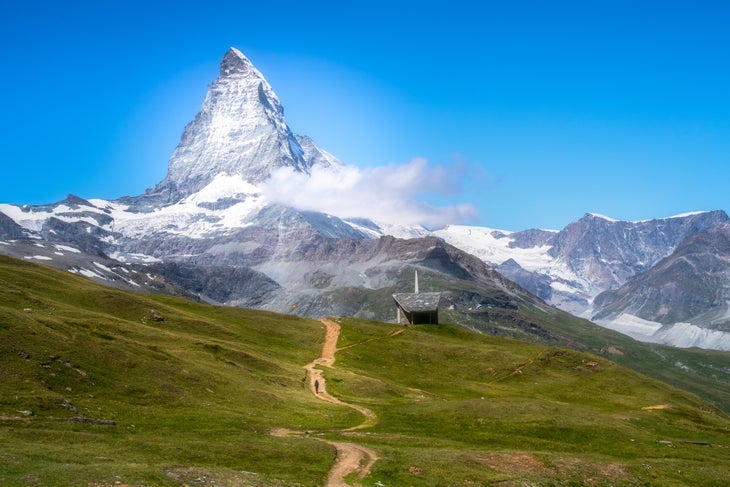
4. The glorious victory was marred when, during the descent, four of the seven climbers in the summit party fell to their deaths—a trend that continues to this day. The remaining three, including Whymper, likely would have fallen as well if the rope linking the men had not broken.
5. The second route up the Matterhorn, the Lion Ridge from Italy, was completed just three days after the first, on July 17, 1865.
6. Since the first ascent, more than 500 people have died while climbing or descending the Matterhorn—an average of three to four per year.
Watch stunning drone footage along the Matternhorn’s ridges in this video:
7. About 3,000 people summit the Matterhorn annually. However, starting this year, by reducing the size of the hut at the base of the most popular route, the Hörnli Ridge, and eliminating camping outside the hut, Swiss officials hope to slash the number of climbers by as much as one-third and reduce crowding on the mountain. About 80 percent of Matterhorn climbers are either guides or clients.
8. Both a railway and a cable car to the summit of the Matterhorn have been proposed. The latter, a tramway from the Italian town of Breuil-Cervinia, was proposed in 1950 but scuttled after tens of thousands of people protested to the Italian government.

9. Emil Cardinaux’s striking poster of the Matterhorn, designed as a card in 1903 and printed as a tourism poster for Zermatt in 1908, is considered the first modern travel poster and a landmark of 20th-century design.
10. In 2019, after an uptick in rockfall related deaths, there was a (brief) discussion about closing the mountain to climbers after an anonymous guide told a Swiss newspaper that climate change had made it increasingly unstable and dangerous.
The post 10 Things You May Not Know About the Matterhorn appeared first on Climbing.
]]>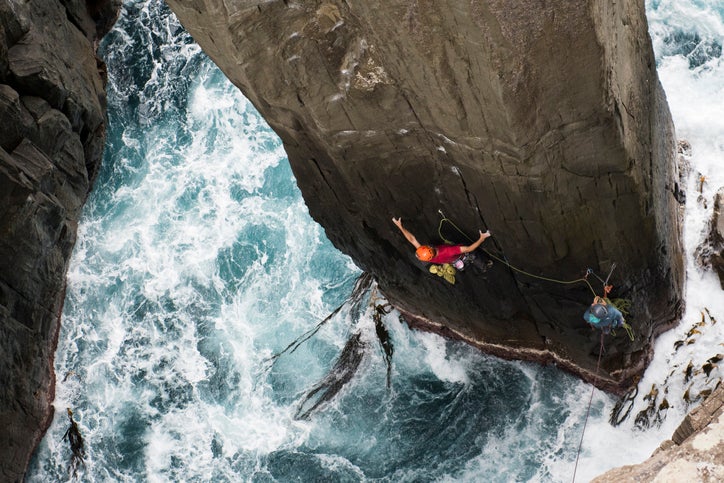
Climbing head injuries can happen anywhere: from the Salathé on El Cap to your favorite little sport crag. Here are five climbers' nightmare scenarios.
The post “A direct hit might have killed me”: 5 Climbers and Their Worst Head Injuries appeared first on Climbing.
]]>
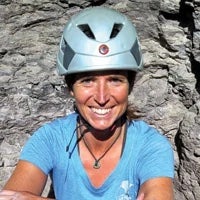
Danika Gilbert
Overlook Cliff, Ouray, CO
The Incident: I always wear a climbing helmet, but one day I took it off between climbs and forgot to put it back on when my boyfriend started leading. Thirty seconds later, a grapefruit- sized rock careened down. I pressed against the cliff, and the rock grazed my skull, opening a gash. A direct hit might have killed me.
The Takeaway: Friends saw me covered in blood that day, but many still don’t wear helmets at that crag, even though stuff comes down regularly there. I’m not sure what the disconnect is. Rockfall is unpredictable.
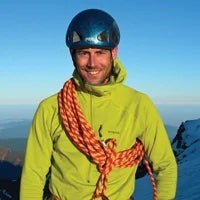
Chris Weidner
El Capitan, Yosemite, CA
The Incident: I was climbing the Salathé Wall and was leading the pitch off Sous le Toit Ledge. It starts with a 5.6 ramp, then goes up a slightly overhanging crack. I clipped into an old fixed piton, then back-cleaned the piece below me. Just as I was reaching up to place the next cam, the piton ripped out. I fell 30 feet, and landed headfirst on the ramp.
The Takeaway: I had a helmet on; it broke in three places, and I really believe that it saved my life. Other than pure sport climbing, I pretty much always wear a helmet.

Carol Kotchek
Bubba City, New River Gorge, WV
The Incident: I had just started up a four-star, 5.10 sport route when my foot slipped and I flew straight back into a tree, spun around, and slammed the ground on my side. Most of the impact was absorbed by my leg, but I had a contusion on my head too. The foam inside my helmet detached from the outside plastic, so I know the helmet absorbed some impact.
The Takeaway: When things go bad in climbing, it happens fast. I learned not to take sport climbing too casually—I was heading up the route with a gym mentality—and always to wear a helmet.
Climbing Magazine is now 50% off for a limited time. Just $24 a year gets you five print issues (four Climbing, one Ascent) delivered to your door. Subscribers also receive unlimited access to over 5,000 articles on climbing.com.
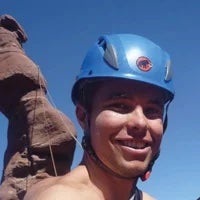
Reid Pletcher
Practice Rock, Boulder Canyon, CO
The Incident: I always wear a helmet trad climbing, but I left the helmet in the car for a day of sport. After five routes, I made an impulse decision to try a trad route to end the day. I fell, two pieces pulled out, and I landed on a ledge. I got two skull fractures, brain contusions, and a subdural hematoma.
The Takeaway: The doctors told me I might have survived because I wasn’t wearing a helmet, as this allowed more swelling and relieved pressure that otherwise could have resulted in termination. I always wonder what would have happened with a helmet. Maybe I wouldn’t be here at all. Maybe it would have helped. I will never know.
[Read: Why Do So Many Climbers Not Where Helmets?]
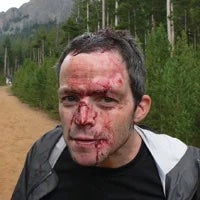
Kelly Cordes
Wizard’s Gate, Estes Park, CO
The Incident: I hopped on a wildly overhanging 5.13a sport climb, and I had a heel hook when my forearms flamed out. My hands came off, my heel stayed on, and somehow I flipped upside down, spun, and swung back into the rock headfirst. Leave it to me to take the safest form of climbing and make it as dangerous as possible. I got 13 staples in my skull—I could have put a TCU in the gash—and 14 stitches in my face.
The Takeaway: I tend to wear a helmet. Though, as time wears on, I’ve gotten more lax about it. If you say, “Always, always, always wear a helmet,” well, what about in the gym? You’ve got to be smart and look at the probabilities.
How to find the best climbing helmet for you
Guiding principle
Only buy a helmet that’s comfortable to wear—and that you’re comfortable wearing. If you hate your helmet because it has too much or too little ventilation, pinches your sunglass stems, or you feel like a dork with it on, you’ll never use it.
Get the right fit
Make sure it sits horizontally across your forehead, just above your eyebrows. Those cute kids with their helmets tilted back over gap-toothed grins might as well have targets painted on their foreheads. Try on multiple sizes for the best fit (keep in mind you may wear a hat underneath— always choose a low-volume hat without any “button” on top). Adjust the chinstrap and headband so the helmet is centered on your head and won’t shift backward (exposing your forehead) or side to side (exposing the temples). Test the fit by snugging up the headband and shaking your head with the chinstrap unbuckled. The helmet should stay put. Before buying, wear it with your pack on—make sure you can still look up comfortably.
Helmet or No Helmet? The top factors influencing climbers’ decisions
You’re more likely to wear a climbing helmet if…
- Peers wear helmets and encourage their use.
- You believe helmets are comfortable.
- Your favorite crags have loose rock.
- You believe helmets are acceptable fashion.
- You stick to grades you can onsight without falling.
- You are older and have more climbing experience.
- You believe helmets are effective at reducing head injuries.
- You have witnessed a major injury at a climbing area.
You’re less likely to wear a climbing helmet if…
- You believe that helmet use reduces performance.
- You climb 5.12 or harder.
- You believe helmets “take away from the aesthetic look and feel of a climbing scene.”
- You frequently climb overhanging routes.
- You believe helmets are too expensive.
- You learned to climb indoors.
- You believe the rock is solid at your favorite crags.
The post “A direct hit might have killed me”: 5 Climbers and Their Worst Head Injuries appeared first on Climbing.
]]>
Some climbers wait to attempt famous free routes until they’re good enough to do them in perfect style. But what if you are never that good? Purists would say you should stay off the climb—leave it for those who have the necessary strength and talent. I say go for it, with a few points of A0.
The post Six Classic Free Routes With Cruxes You Can Skip (Just in Case) appeared first on Climbing.
]]>
I wanted to do Monkeyfinger, but I didn’t climb 5.12. My partner did, though, and she wasn’t going to let me hold her back with any sanctified notions of “saving” the route for a pure free ascent. Monkeyfinger, a classic nine-pitch corner in the back of Zion National Park’s main canyon, has just one 5.12 pitch; the rest is mostly 5.10, with two short 5.11 cruxes. “You can pull on a piece through the hardest part,” she said. “Let’s just go for it.”
And so we did. She fell once on the crux Black Corner and then smoothly redpointed the pitch. On toprope, I groped at the fingertip laybacks, sagged onto the rope, and then yarded on a nut and pulled into a good rest. The other pitches were a blast—and I climbed them all free.
Some climbers wait to attempt America’s greatest free routes until they’re good enough to do them in perfect style. But what if you are never that good? Purists would say you should stay off the climb—leave it for those who have the necessary strength and talent. I say go for it: Do your best to free climb, but don’t hang your head in shame if you pull on a piece or stand on a bolt. Very few climbers consistently cruise long 5.11 to 5.13 routes.
Of course, you should not tell anyone you “did” Astroman when you aided through the crux boulder problem near the bottom and hung at the mouth of the Harding Slot. But take it from me: Climbing Astroman in such “A0” style is still a challenging, highly rewarding day. And as long as you’re completely honest about your efforts, why should anyone else care? You can always go back for the redpoint.
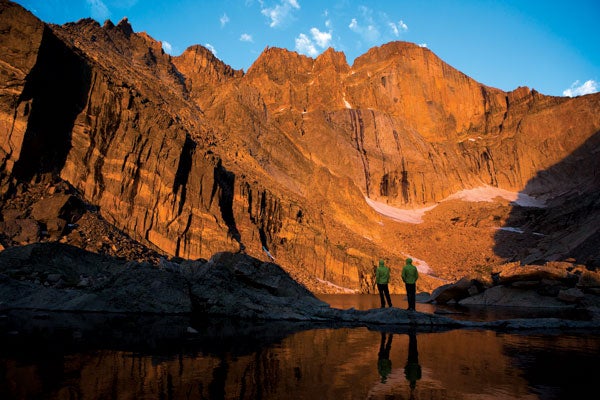
D7 (5.11d/5.10, 7 pitches)
Longs Peak, Rocky Mountain National Park, Colorado
Following a continuous line of cracks straight up the left side of Longs Peak’s famous Diamond, D7 became the most popular route up the face soon after its first ascent in 1966, and when John Bachar and Richard Harrrison freed the line in 1977, it quickly became the route of choice for talented climbers looking to step up from the Diamond’s “easy” free climbs. The five- to seven-pitch route’s popularity has left a legacy of fixed pitons and other pro that make it nearly a clip-up for free climbers—many carry only a single set of cams and nuts and a harness racked full of quickdraws.
Low on the route, the climbing is mostly steep, juggy 5.9—a surprise on such an intimidating face. This moderate terrain ends with a spot of 5.10 just below a wide crack, and then another 5.10 pitch. You can aid all of this section (at least one four-inch piece needed for the wide), but it will go much quicker if you’re able to free most of it. Above lie the cruxes: a 15-foot bulge slashed with parallel finger cracks, another short 5.11 passage, and then a thin crack that starts hard (5.11a) but soon widens and eases. You can do these cruxes with A0 tactics, but if you’re heading up the route expecting to aid, a single pair of alpine aiders will make the task much easier.
The Casual Route (5.10a), the easiest line up the Diamond, also gets easier with a wee bit of aid. A couple of tugs on gear (there’s usually a fixed pin) at the crux bulge on the seventh pitch bring the route’s grade down to about 5.9— though 5.9 still feels plenty hard at over 13,500 feet.

The Prow (5.11+/5.10a, 6 pitches)
Cathedral Ledge, New Hampshire
After many attempts by many different New Hampshire climbers, Jim Dunn snagged the first complete free ascent of The Prow in 1977, and a quarter-century later it remains one of New England’s great free climbing prizes. The Prow is also a traditional favorite for clean aid practice—a sort of mini–big wall warm-up for Yankees heading to Yosemite Valley. The route takes a plumb line up Cathedral’s steepest buttress for six mostly short pitches, and the numerous fixed pitons and smattering of bolts make it an appealing target for climbers of all stripes: free, aid, and those who mix it up a bit.
The Prow is a perfect route for “might as well give it a try” free climbing: You can safely go for it, but if you come up short, it’s no bother to aid through and try again on the next pitch. As local guide Mark Synnott says, “The hard moves are definitely cruxy, but they’re short, and you almost always get back to a good stance within a few moves.” Half of The Prow’s pitches are upper end 5.11, but the second- and fourth-pitch cruxes are essentially boulder problems that quickly succumb to A0 tactics; the fourth pitch continues with a sweet 5.11a finger crack that can be freed or aided.
The route’s crux fifth pitch heads up a corner and through a small roof; the difficulties are sustained, but the pitch is quite short, and there’s usually lots of fixed pro. Another superb finger crack (5.10a) gains the top and superb views of the Mt. Washington Valley. From here, it’s usually easy to convince a highly impressed tourist to drive you back down the paved summit road.
Monkeyfinger (5.12b/5.10+, 9 pitches)
Zion National Park, Utah
Discovered by the great Zion pioneer Ron Olevsky, and then free-climbed in 1984 by Pokey Amory and Drew Bedford, Monkeyfinger has all the elements of a classic: a compelling line, three-minute approach, and solid sandstone. It also has some nice surprises: The poorly protected start of the second pitch (5.10+/5.11-) can be avoided with a step left into a better crack, and the intimidating offwidth on pitch six has jugs hidden in the back of the crack. The crux Black Corner (5.12b, pitch three) is short and easily aided by pulling on a couple of nuts or tiny cams. If you do it this way, the free-climbing crux will come on the following pitch, with a hard move around a roof. This, too, will succumb to a tug on a piece, but with good pro at your waist, give free climbing a try!
If you cruised the crux corner, another challenge awaits on a sixth-pitch variation called the Monkeyfinger Crack, a 5.12 finger-jamming exercise on the exposed wall left of the Monkey House alcove. Most people avoid this alternative by continuing up a short 5.10+ layback and jam crack, followed by two funky pitches of face climbing and general desert weirdness. The rock quality deteriorates on these final pitches, and some people start rappelling at the Monkey House, before finishing the route. But if you really want the full Zion experience, be sure to top out on the canyon rim before rapping.
Levitation 29 ( 5.11c / 5.10, 10 pitches)
Red Rock National Conservation Area, Nevada
You can bet Lynn Hill and John Long didn’t yank on any of the plentiful bolts on this route when they free climbed it in 1981, shortly after the first ascent by George and Joanne Urioste and Bill Bradley. But if the brief 5.11 cruxes on the second and fifth pitches spit you off, don’t hesitate to grab a silver handhold and keep going—the rest of the climbing is totally worth it.
The setting for Levitation 29 is amazing: a two to three-hour approach brings you to a shelf high over Oak Creek Canyon, at the foot of the Eagle Wall’s rippled sandstone. Although the route has dozens of bolts, it’s not a sport climb; you need a small rack and good trad skills, especially for the first two pitches. The crux crack on the fifth pitch requires strenuous fist jams for free-climbing success, but the bolts alongside offer an easy out. Many rappel after the sixth pitch, when the sandstone begins to soften, but good climbing lies above, and the walk down is gorgeous.
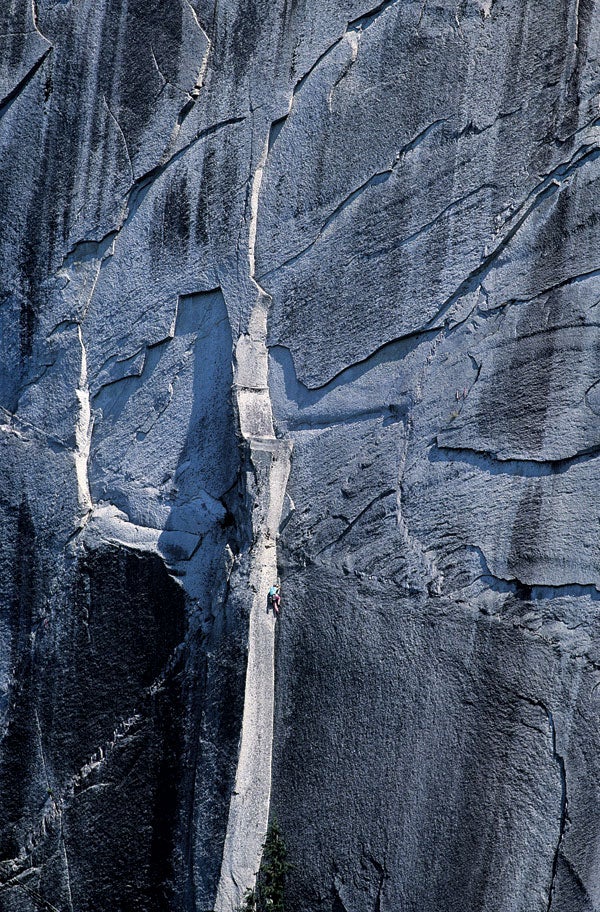
Grand Wall (5.13b / 5.10+, 9 pitches)
Stawamus Chief, British Columbia
With 12 pitches of superb granite crack and face climbing up the center of Squamish’s premier cliff, the Grand Wall is a must-do for any trad climber. And since almost no one does this Canadian classic all-free, there’s no need to feel ashamed about the A0 asterisk on your ascent. In fact, the bolt ladder on pitch nine has a fixed boat rope that you can hand-over-hand up, merrily clipping bolts as you went. Scott Cosgrove and Annie Overlin found a way to bypass this ladder with a 5.13 variation in 2000, but most people today aid this pitch, as well as a short bolt ladder below the towering Split Pillar. (It should be noted that local strongman Sonnie Trotter says the free variation is “outstanding climbing in an even more outstanding position,” if you’re up for it.) Many also use a bit of aid, at least for rest, on the strenuous Perry’s Lieback offwidth; you can use slings for all of these A0 moves—no aider needed. For most climbers, the real free-climbing crux comes on the Sword, a 5.11a layback and crack pitch, where the hard parts are brief with good rests in between; if you pump out and hang for a moment, you’ll knock the grade down to about 5.10+.
For the full experience, continue another four pitches via Roman Chimneys (5.11d). Most climbers will be more than happy to call it good and escape via Bellygood Ledge.
South Buttress Right (5.11b / 5.10a, 7 pitches)
Mt. Moran, Grand Teton National Park, Wyoming
South Buttress Right is the best free climb on Mt. Moran, the northernmost of the Teton giants. The route goes nowhere near the summit of the 12,605-foot peak—you rappel after finishing the seven-pitch climb—but it’s still a full backcountry experience. The most efficient approach is to canoe across Leigh Lake, and most climbers camp at the foot of the route for an early start.

You can cut this Teton classic down to size by liberally applying one of the best A0 techniques: a little help from the rope. After a couple of pitches of moderate alpine granite, the crux comes at an intimidating hanging corner, with a laser-cut undercling (often wet) and layback crack, with insufficient foot holds. But fixed pitons and tiny cams provide decent pro—or, if you’re so inclined, a chance to cop a rest or lean for the next hold with a kernmantle assist. Some of the wildest climbing of the route comes above the crux, on the easy but hyper-exposed Great Traverse and the two 5.9/5.10 pitches at the top. The last pitch is a 5.10 slab with poor bolts—even if you expect to A0 the crux, make sure the leader of this pitch is solid on 5.10.
The post Six Classic Free Routes With Cruxes You Can Skip (Just in Case) appeared first on Climbing.
]]>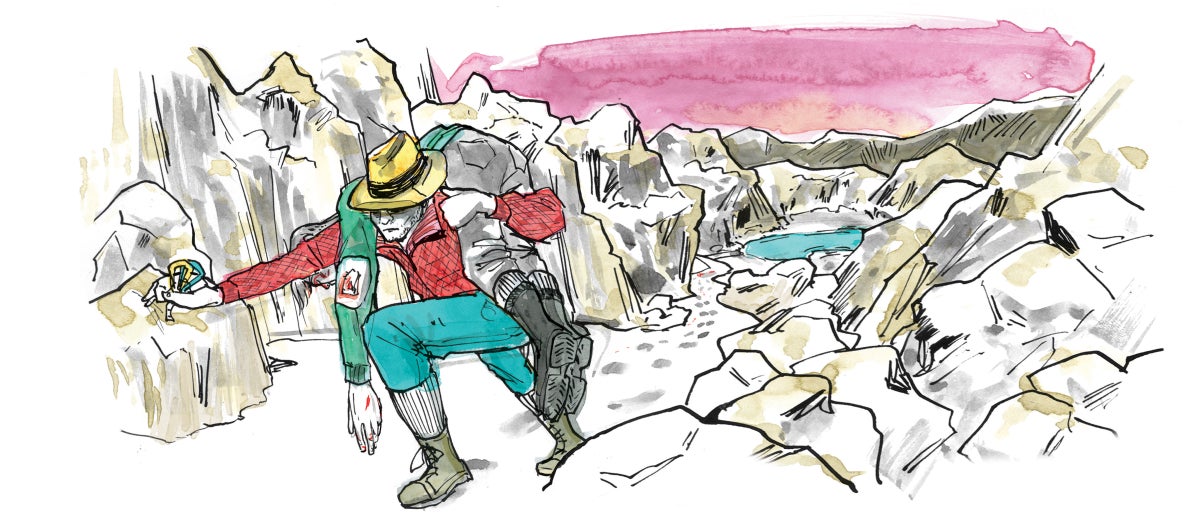
What do you do if you find an injured solo climber halfway up a 1,600-foot face? In the 1930s, the only option was a high-elevation piggyback ride.
The post Soloist Is Stranded Midway Up Longs Peak. His Rescuer Piggybacks Him Up 5.4 To Safety appeared first on Climbing.
]]>
Climber: Hull Cook
Location: Longs Peak, Colorado
Date: Summer 1931
The Scene
During the early 1930s, Hull Cook was one of several guides who worked summers at the old Boulder Field Shelter Cabin on Longs Peak, the high point of Rocky Mountain National Park. “One evening, after dinner, I thought that I heard a most unwelcome sound: the yodeling signal, which we used as a call for help,” Cook wrote in an unpublished memoir of this era. “I rushed outside, hoping that I was mistaken, but there it was again.”
In those days, Longs Peak resembled a peak in the Alps, with a staffed hut at 12,750 feet where overnight guests could get hot meals and then climb the mountain with a guide. (The hut closed in 1937.) Cook and the other guides were expert climbers, at least by the standards of the day. As the only locals with technical climbing expertise, they were also the de facto rescue team.
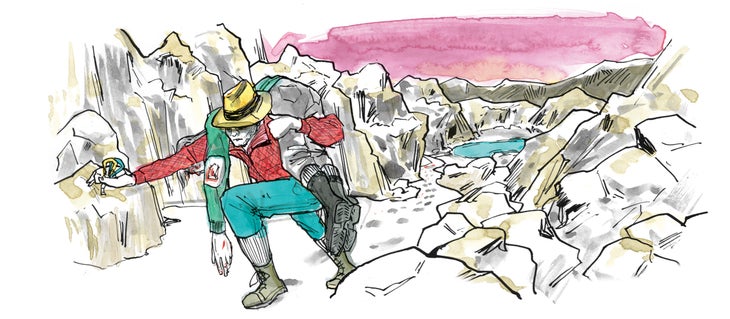
Cook grabbed a rope, first aid kit, and a flashlight and rapidly hiked up to Chasm View, the ledge at the foot of the north face, overlooking the famed Diamond wall. Wayne “Gilly” Gilbert, the guide who had yodeled to get Cook’s attention, pointed to a climber who had fallen and was lying on Broadway, a big ledge system that cuts across the northeast face, about 800 feet above the Mills Glacier.
“The approaching darkness made it difficult to even see the victim,” Cook wrote. “Gilly and I decided at once that he could be reached [most] quickly from above. Accordingly, we climbed to the top of the peak, crossed southward above the Diamond, and descended to Broadway.”
When Cook reached the man, Leonard Thomas, he was “babbling incoherently about falling.” He had slipped after changing from hobnailed boots into hemp-soled “climbing shoes” on the upper face. His pack had plunged to the Mills Glacier, and he had been lucky not to follow it. Now the question was: How were they going to get him off the face?
The Response
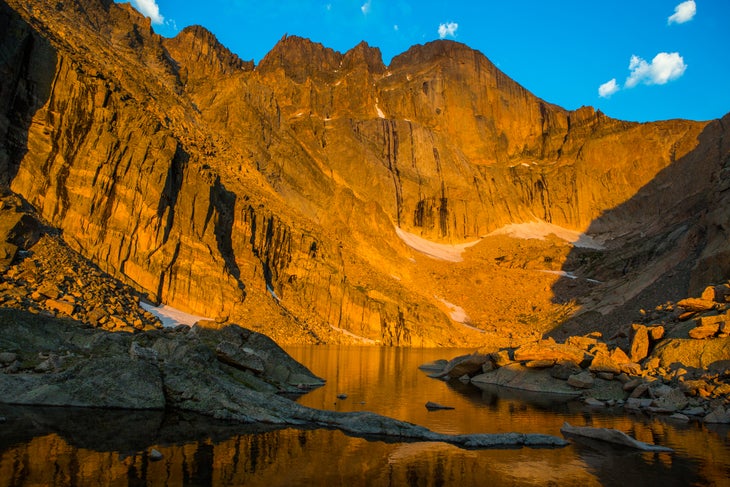
With a single braided manila rope, probably only 120 feet long, no climbing harnesses, no rappel devices, and no more than a handful of pitons and carabiners, Cook had few options for evacuating an immobile victim from a ledge at 13,200 feet, now in pitch darkness. The only way out was back up the route he and Gilly had just descended. Kiener’s Route is the easiest way to climb the upper east face of Longs, but it has two pitches of low fifth class climbing and hundreds of feet of steep scrambling. Thomas had a concussion, broken collarbone, and assorted lacerations and contusions. He was in no shape to climb, and they couldn’t haul him, so the only way up was to carry him.
This was standard practice, according to Cook, who frequently would carry stricken hikers or climbers. “The dead ones you had to carry lopped over both shoulders, but we’d get (the live ones) set on our shoulders so that we had plenty of breathing room. Tell them to put their hands around our forehead and say, ‘Just keep your fingers out of my eyes,’ and away you’d go,” Cook wrote.
Gilly had remained one pitch up Kiener’s Route, ready to belay Cook and his cargo. “After securing the rope around his middle, I called up to Gilly to take up the slack. Then, after explaining the shoulder carry to [the victim], I hoisted him into position.” Together, they started traversing narrow Broadway ledge. With a flashlight gripped in his teeth, Cook edged along the sloping ledges, groping for handholds. The tight rope from above did nothing to protect Cook but “provided the reassurance that if I slipped the man would be saved by the rope. He would no longer be my responsibility; he would become Gilly’s problem.”
Now Cook began climbing Kiener’s steep corners—carrying a 150-pound-plus, unstable load draped over his shoulders. Despite this burden, with good holds and his fellow guide belaying, Cook felt “we were home free” on these two steep pitches. He continued carrying the man up about 750 feet of third- to fourth-class terrain, with Gilly moving higher to establish a new belay each rope length. Then they climbed across the top of the Diamond, at ca. 14,000 feet, and down the north face. Here, a steel cable bolted to the rock allowed Cook to hand-over-hand down fifth-class rock.
The victim “was still riding on my shoulders,” Cook recalled. “Each time his toes suddenly slipped off the rock, he apparently relived the terror associated with his fall, for each time he let out a shriek that would frighten a banshee.” Finally they reached the safety of the hut, where Thomas spent an uncomfortable night and then rode out on horseback the next day.
Although Cook’s strength and stamina are self-evident from this story, he also benefitted from exhaustive knowledge of Longs Peak, gleaned from several summers of working as a guide and exploring every face of the mountain. When it came time to carry an injured man up a technical route in the dark, he had the confidence of knowing the route intimately.
Cook’s efforts prompted the victim’s father to nominate him for a Carnegie Medal for heroism, but this proposal was quashed because Cook was a professional guide (though he wasn’t working for the victim). The climber’s father, however, gave Cook a reward of $50 [at least $500 today]. Cook’s father, meanwhile, told him, “You should have taken that Carnegie fellow up there [on Longs]. He might have changed his mind.”
The post Soloist Is Stranded Midway Up Longs Peak. His Rescuer Piggybacks Him Up 5.4 To Safety appeared first on Climbing.
]]>